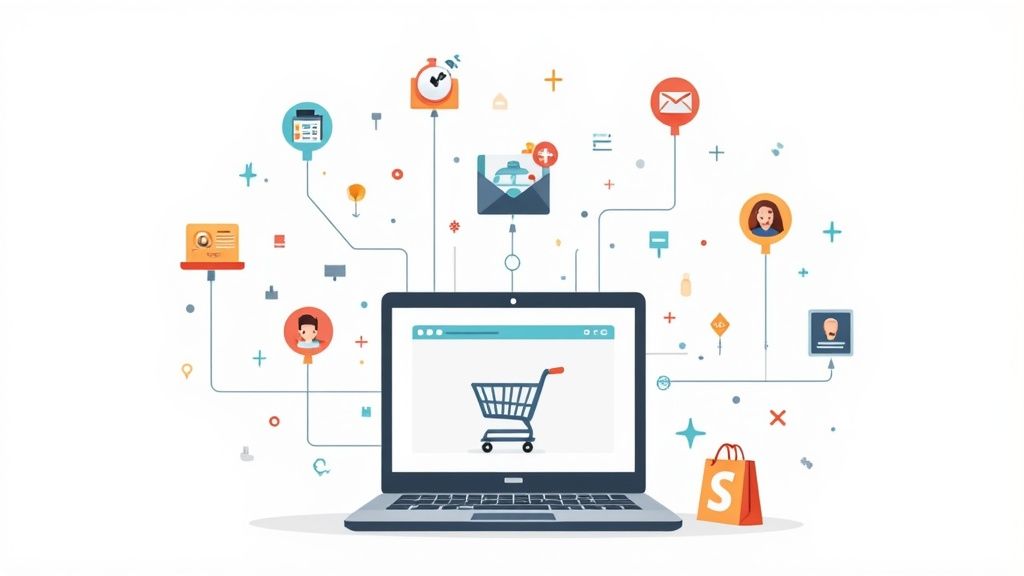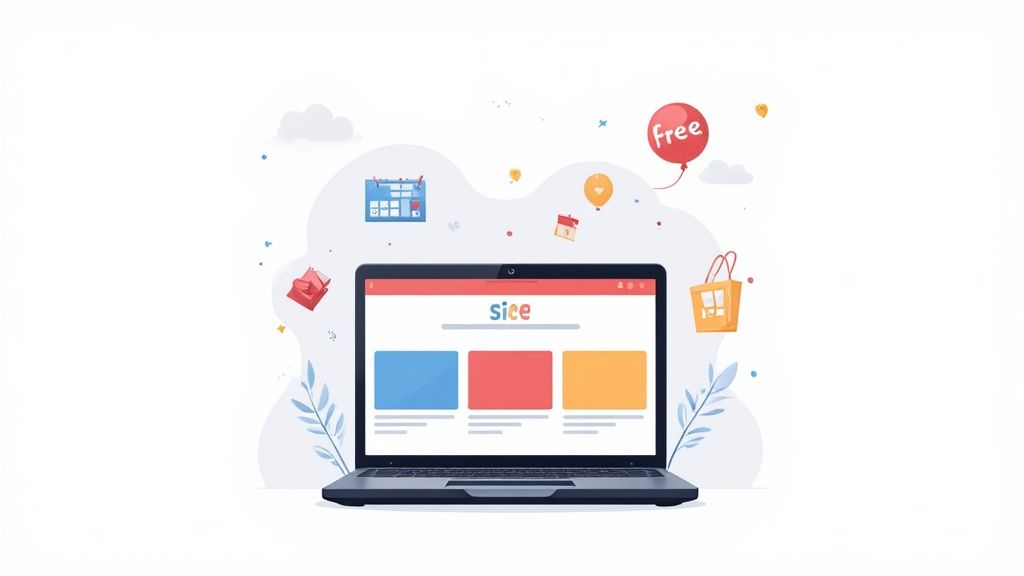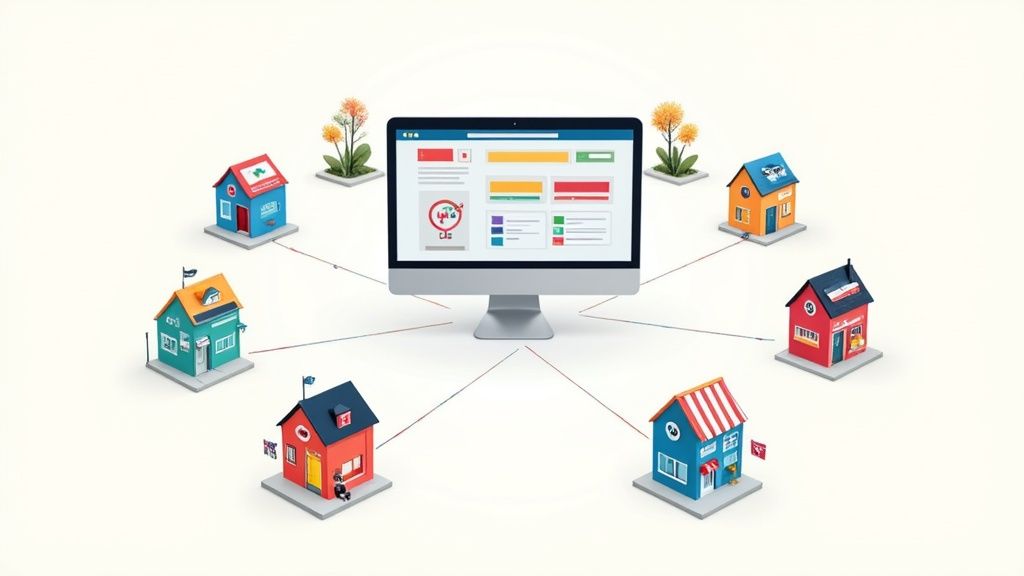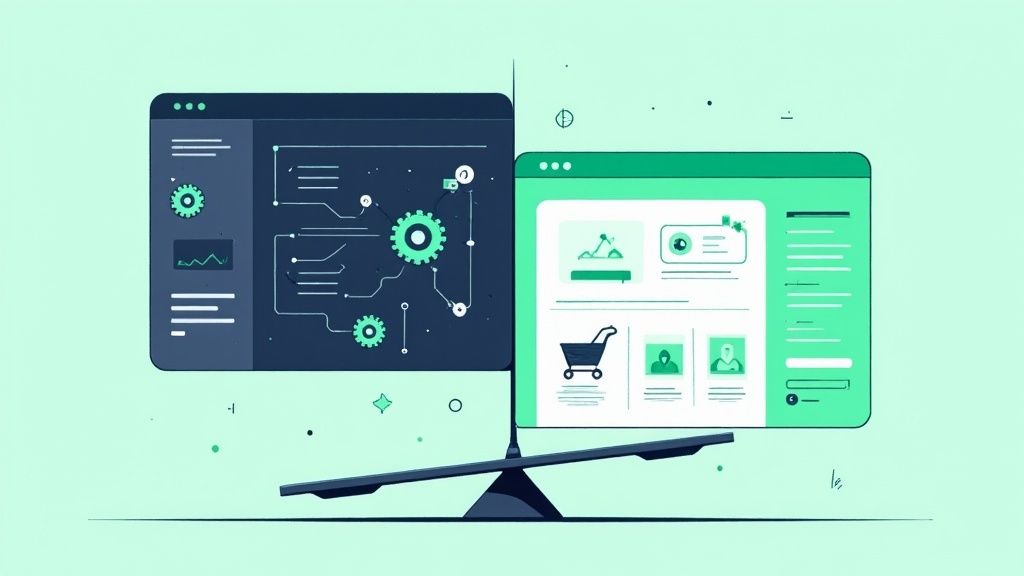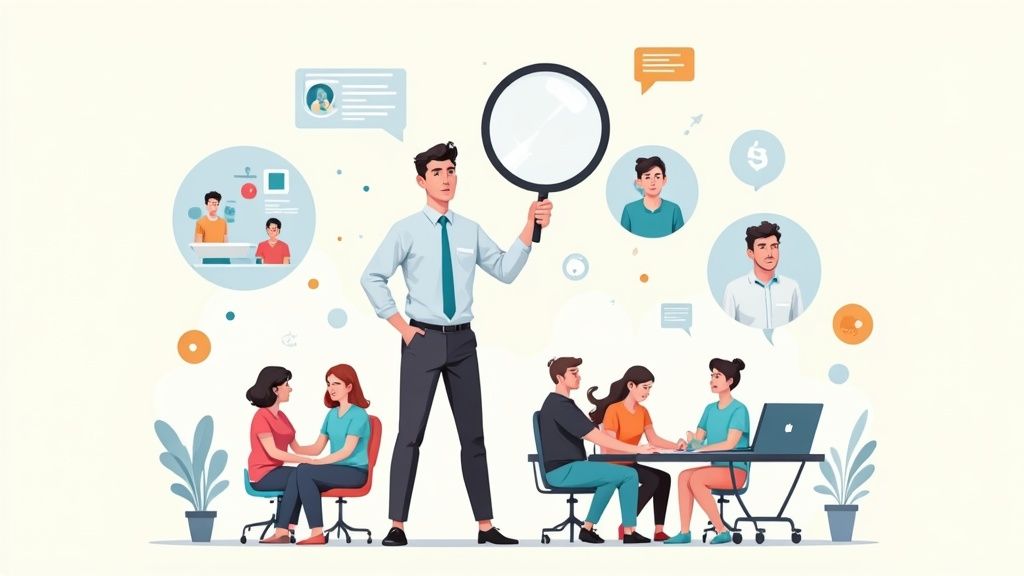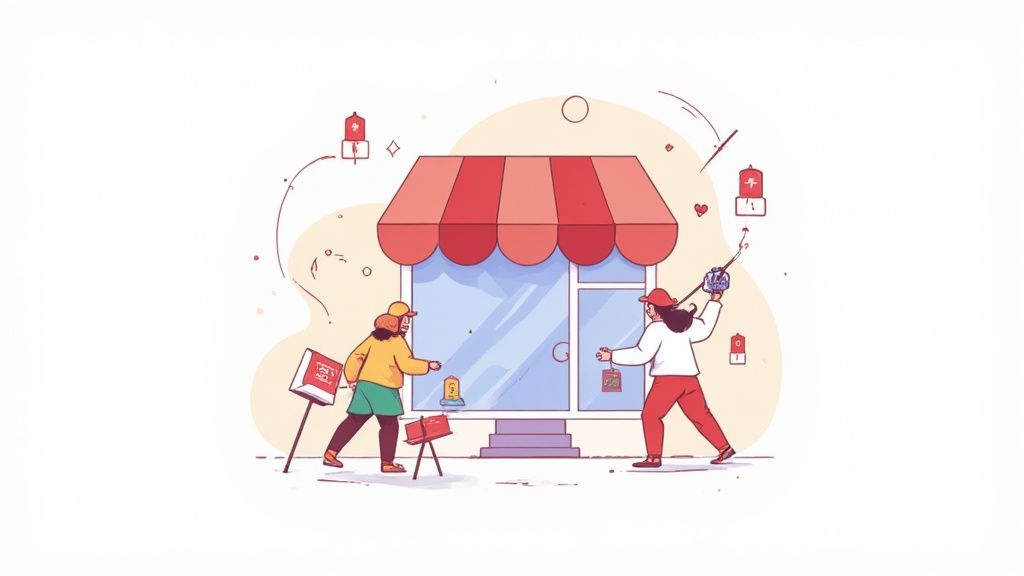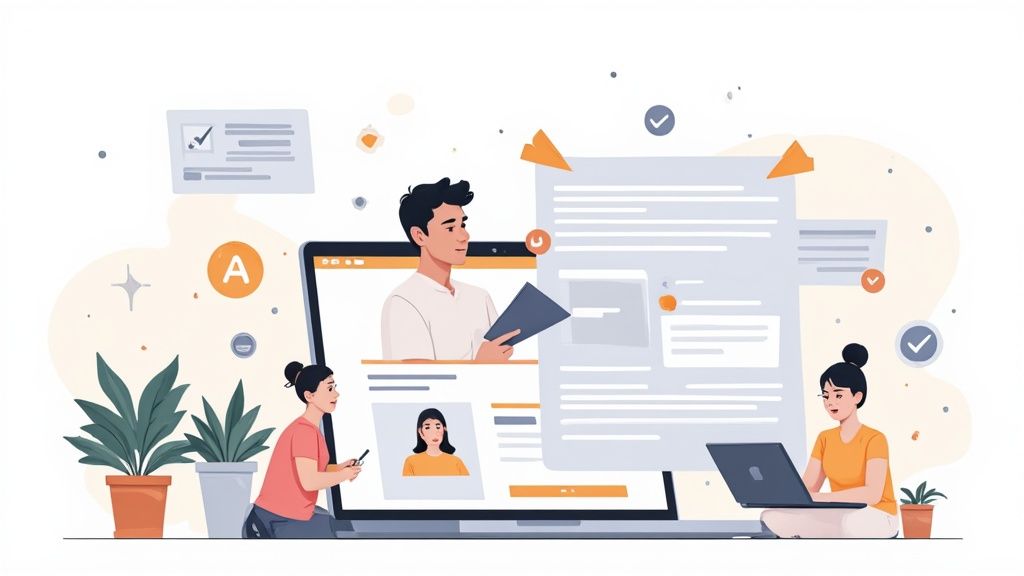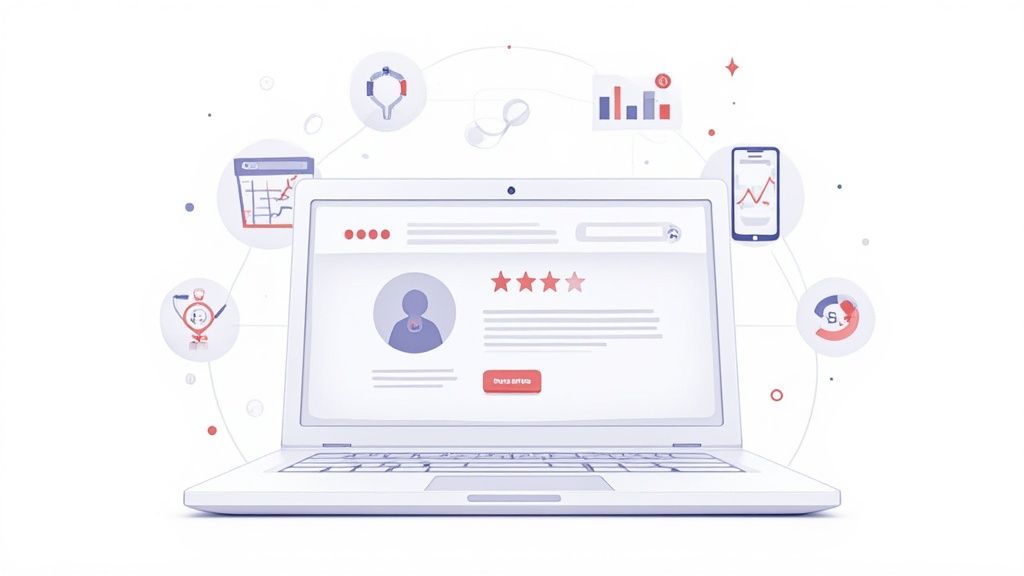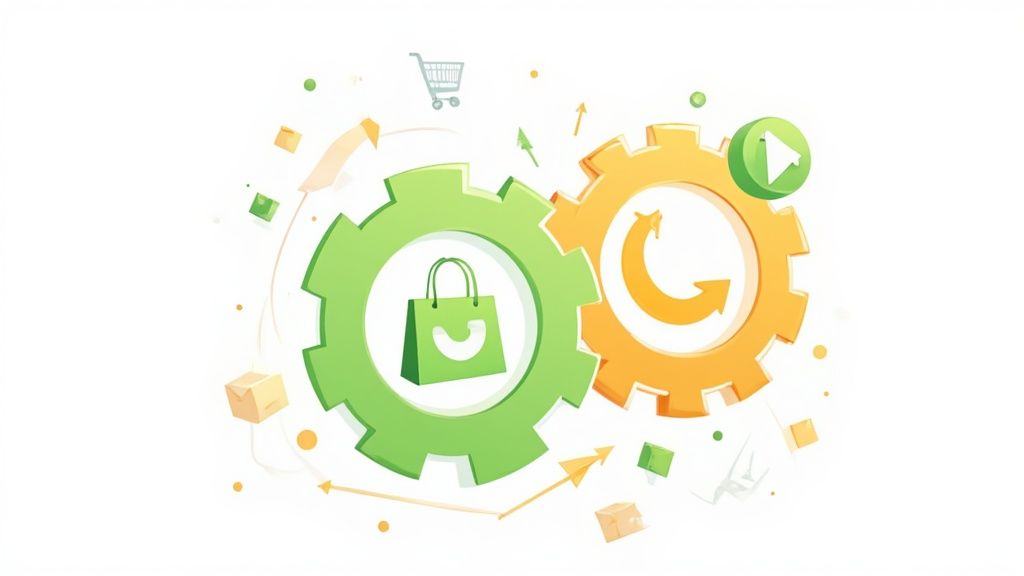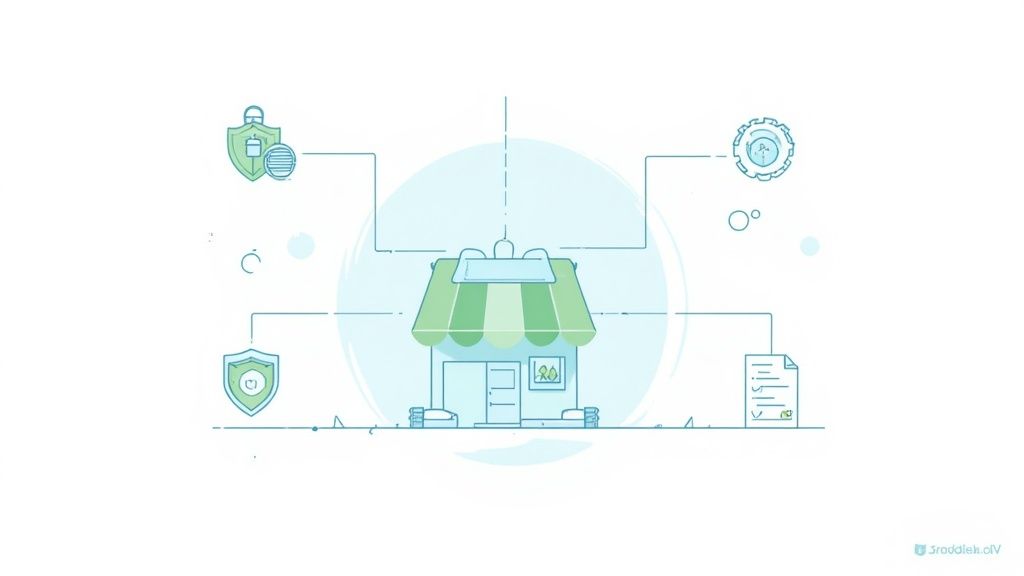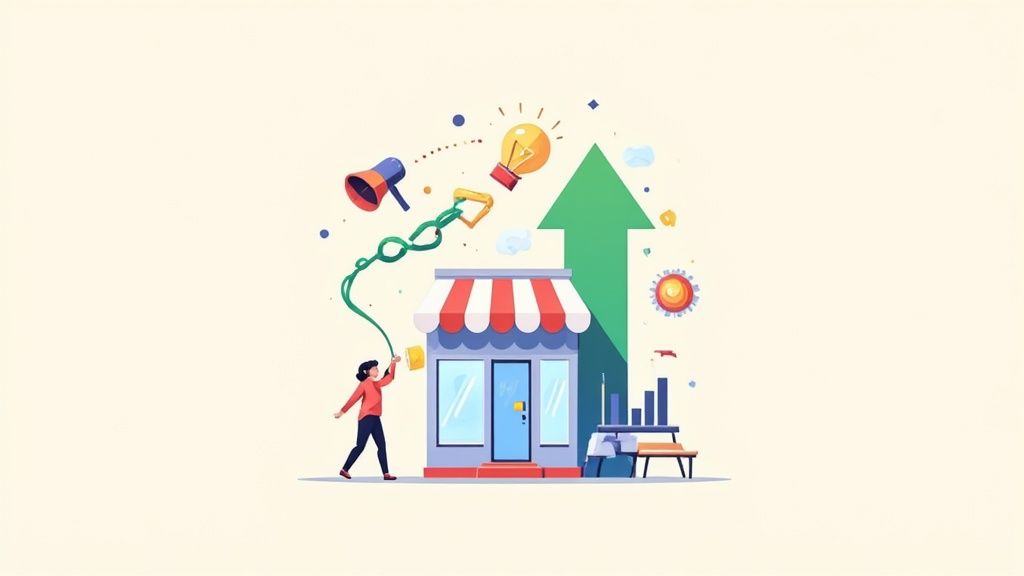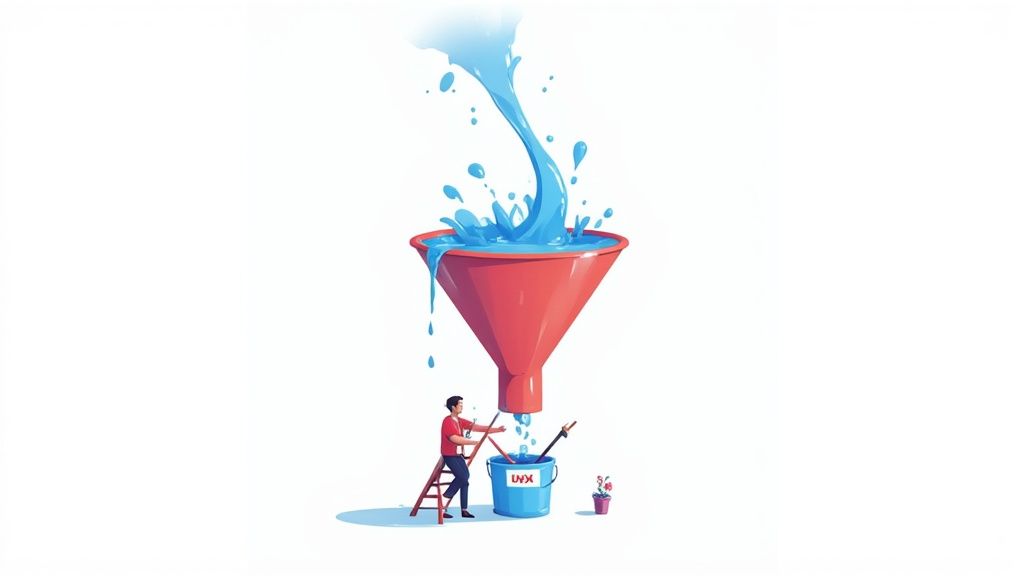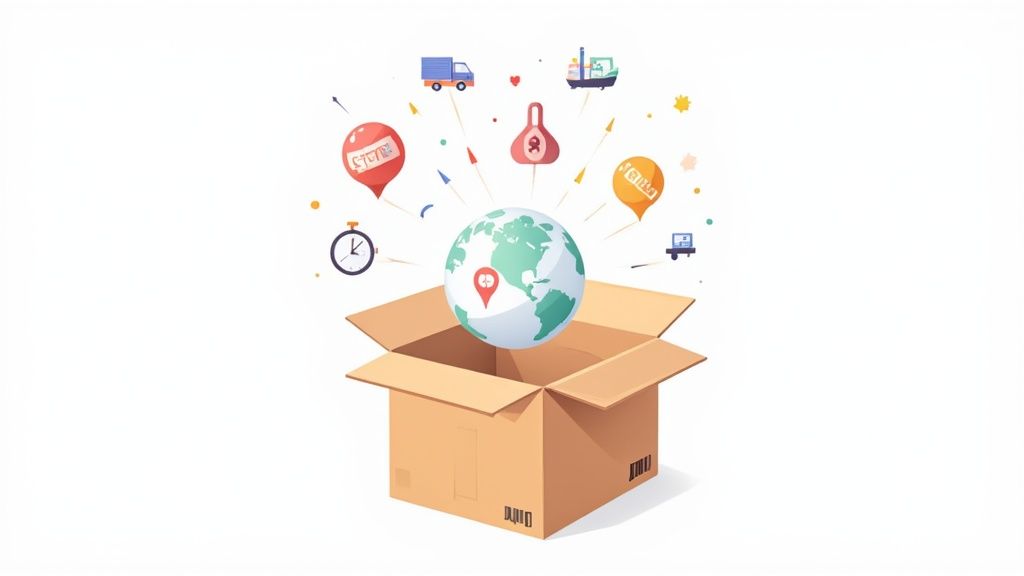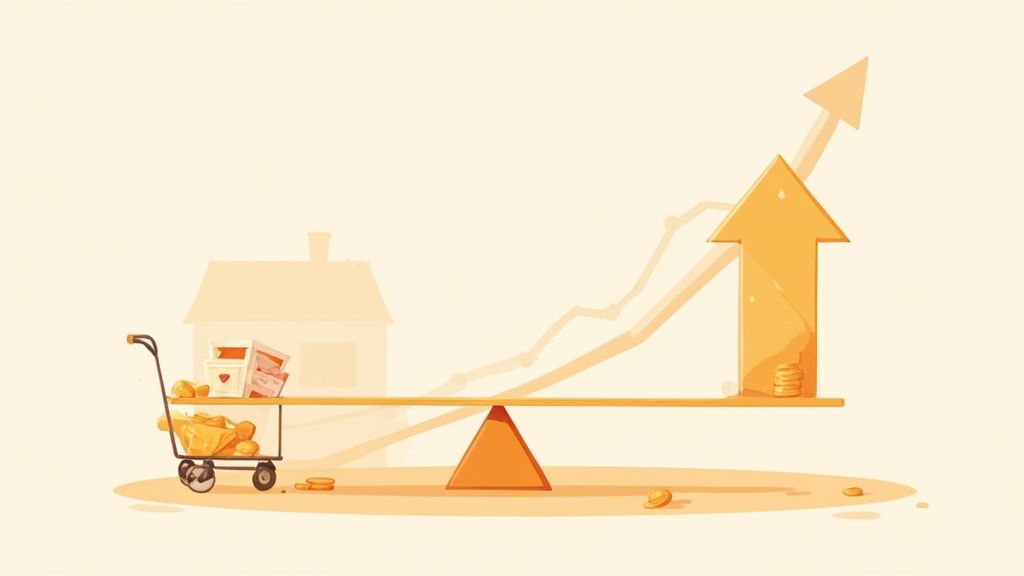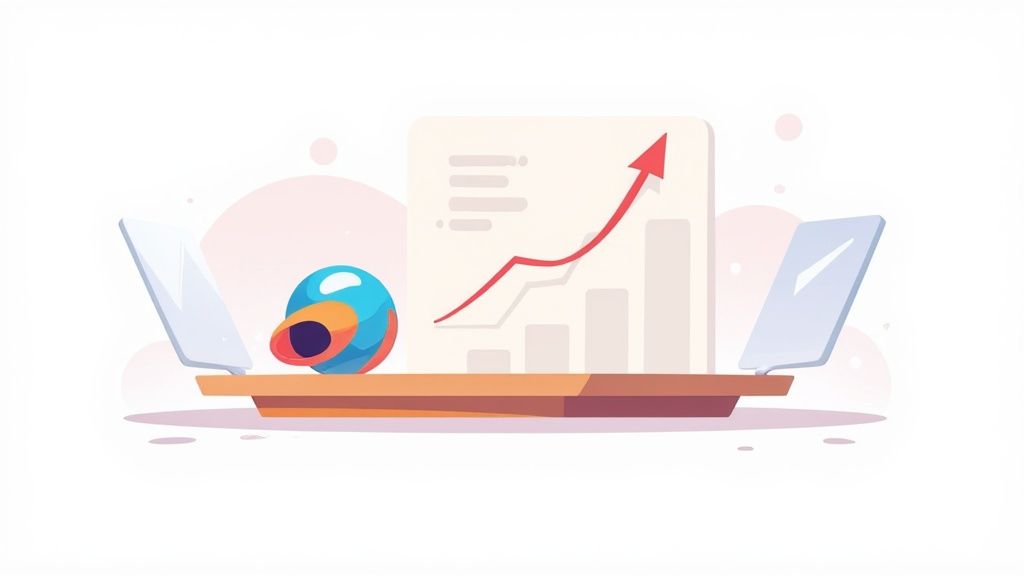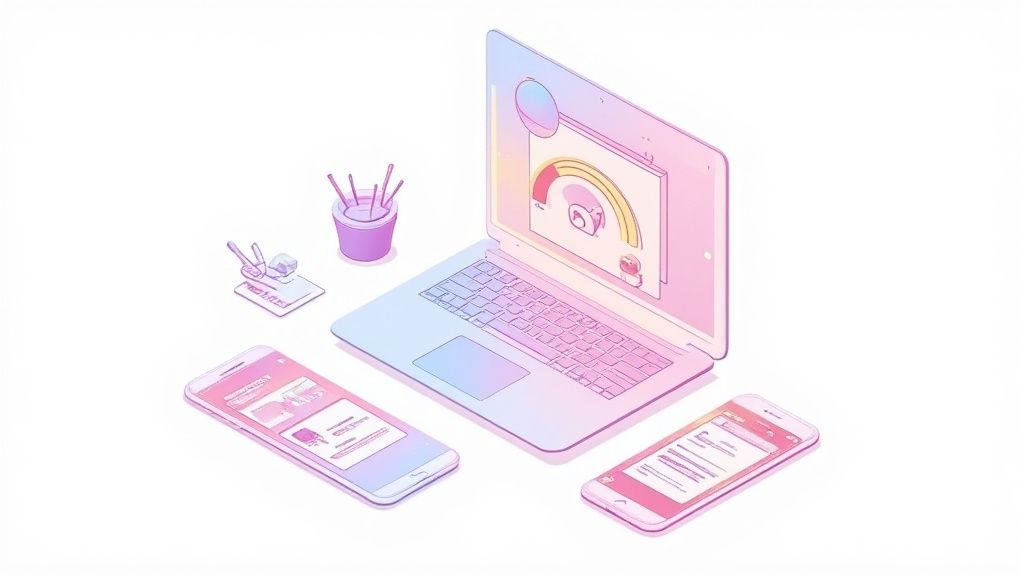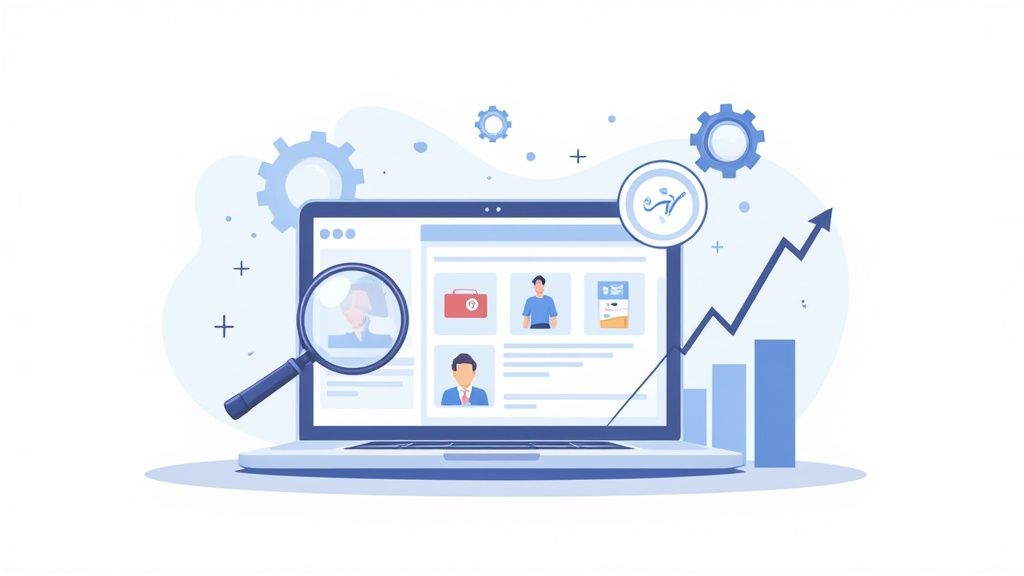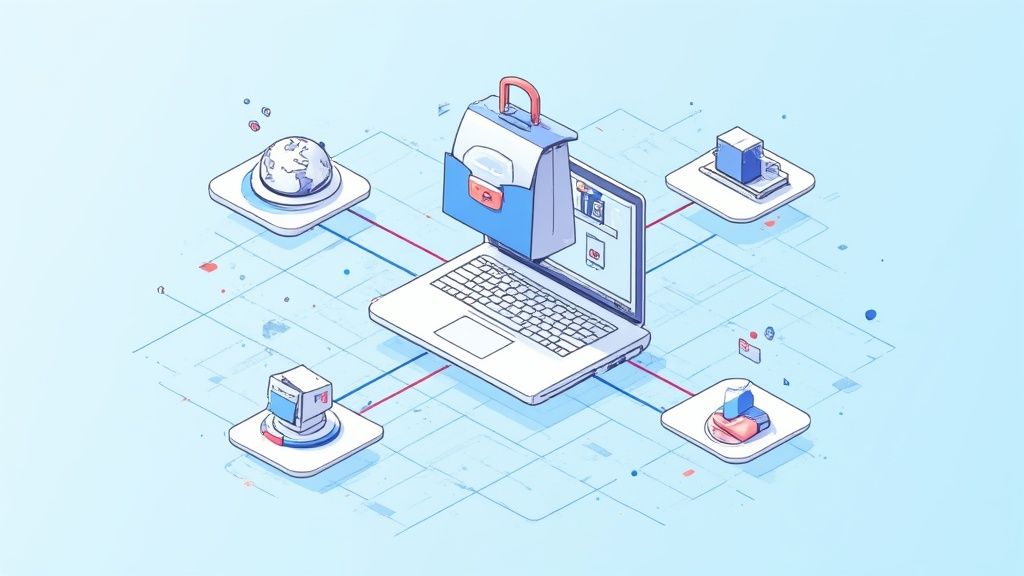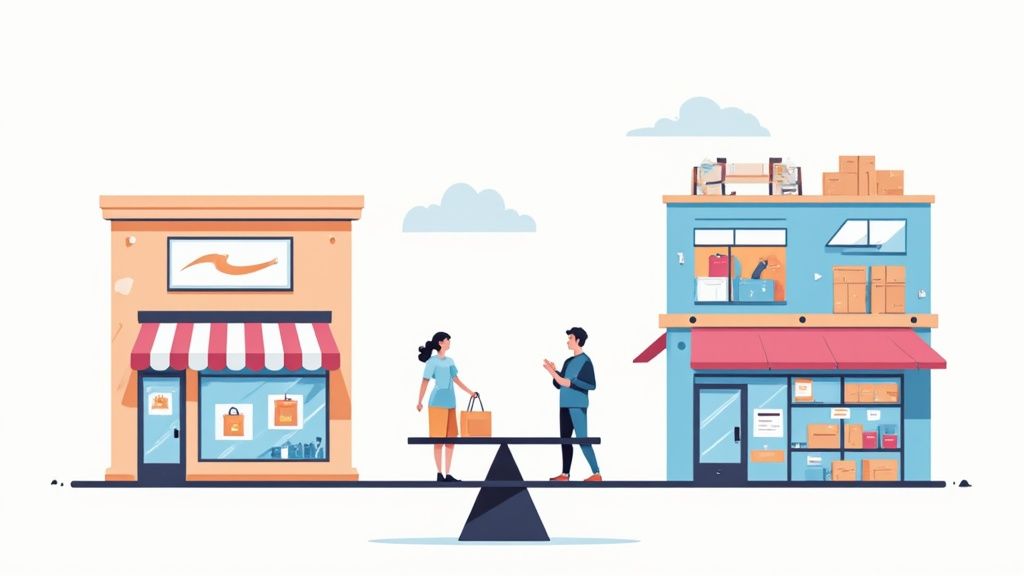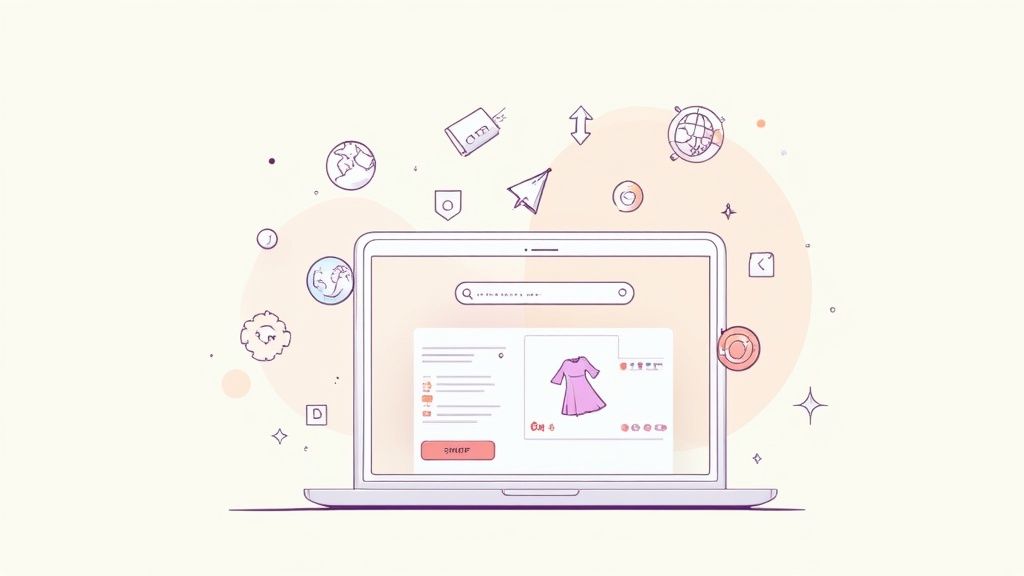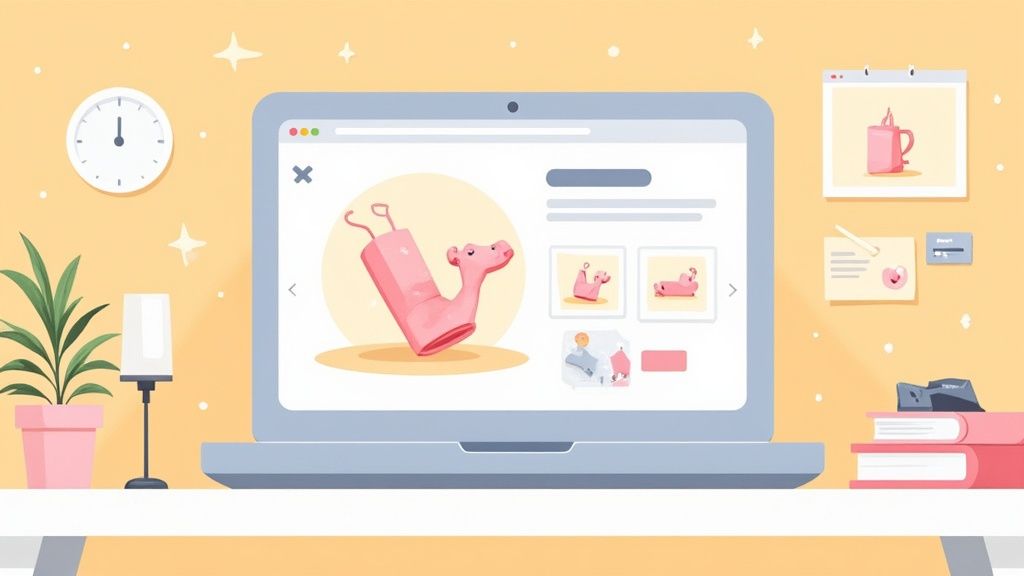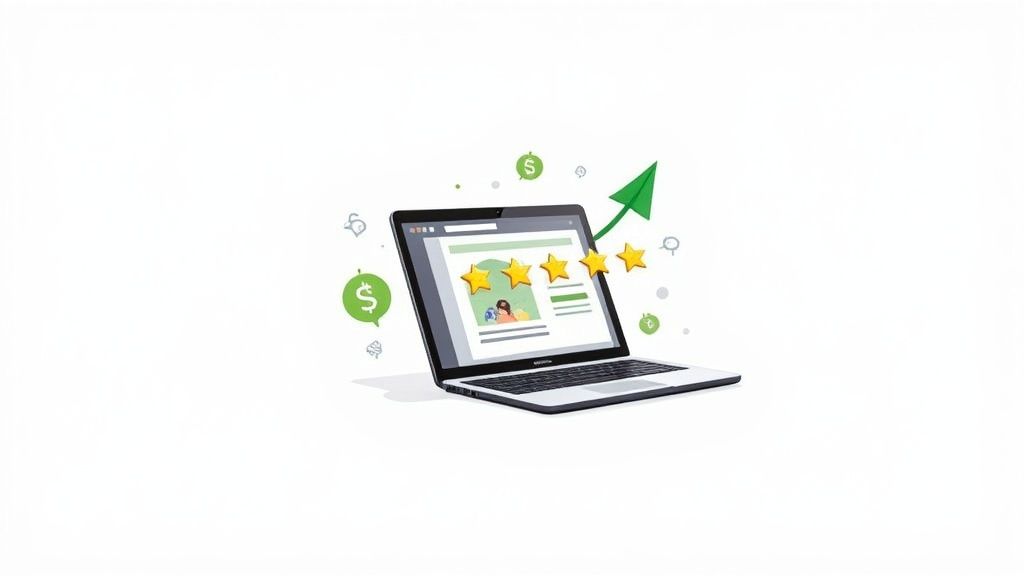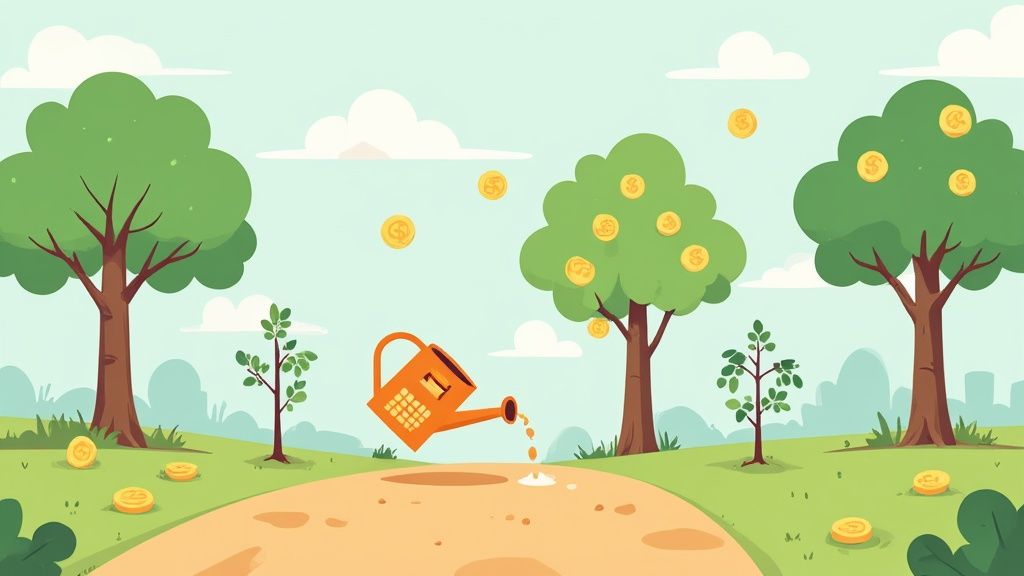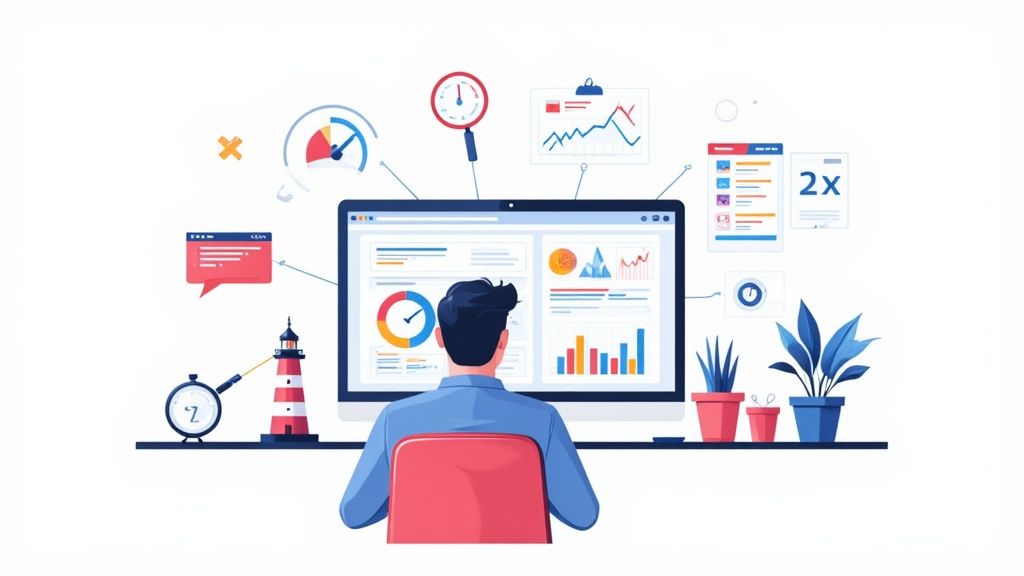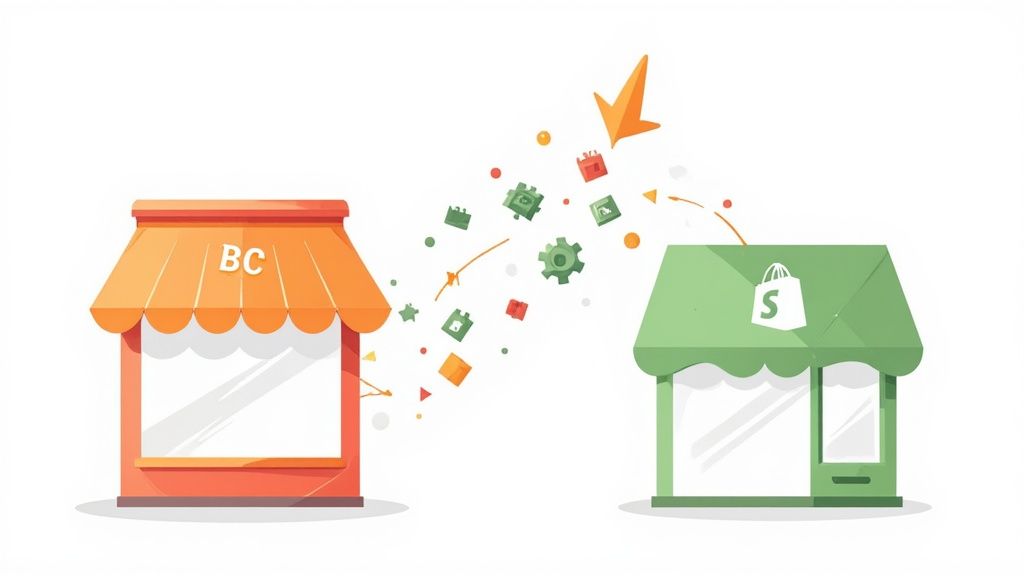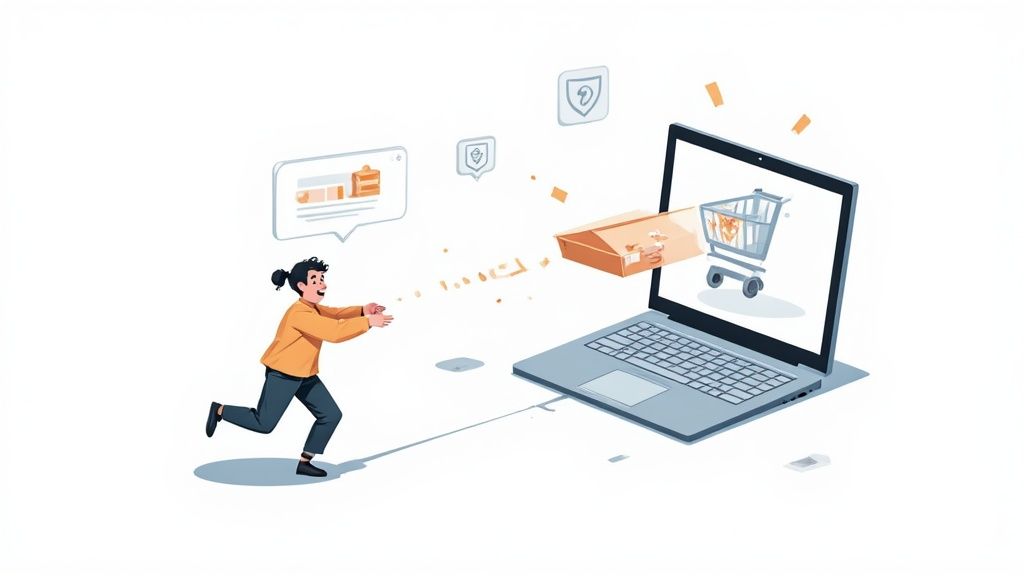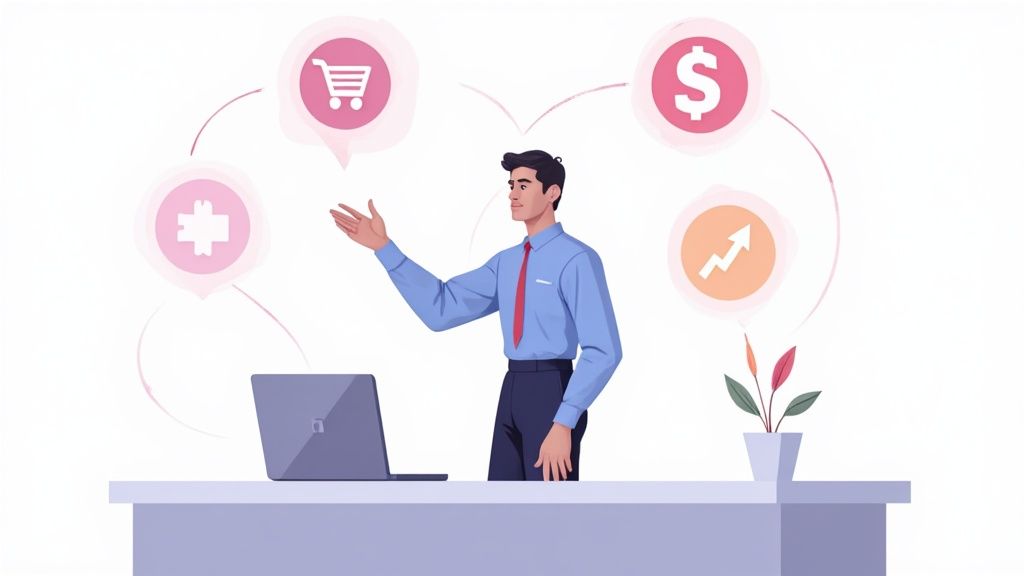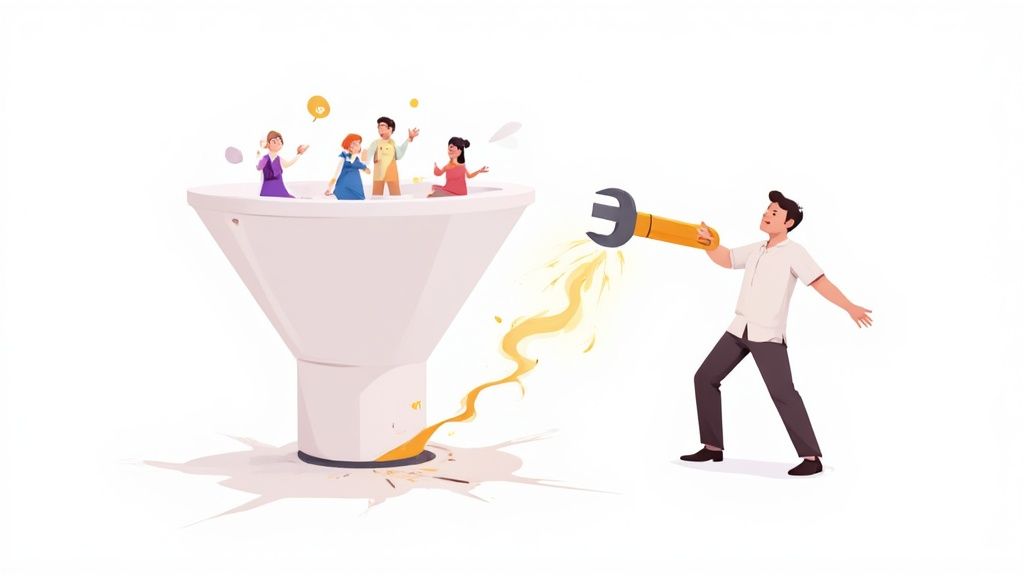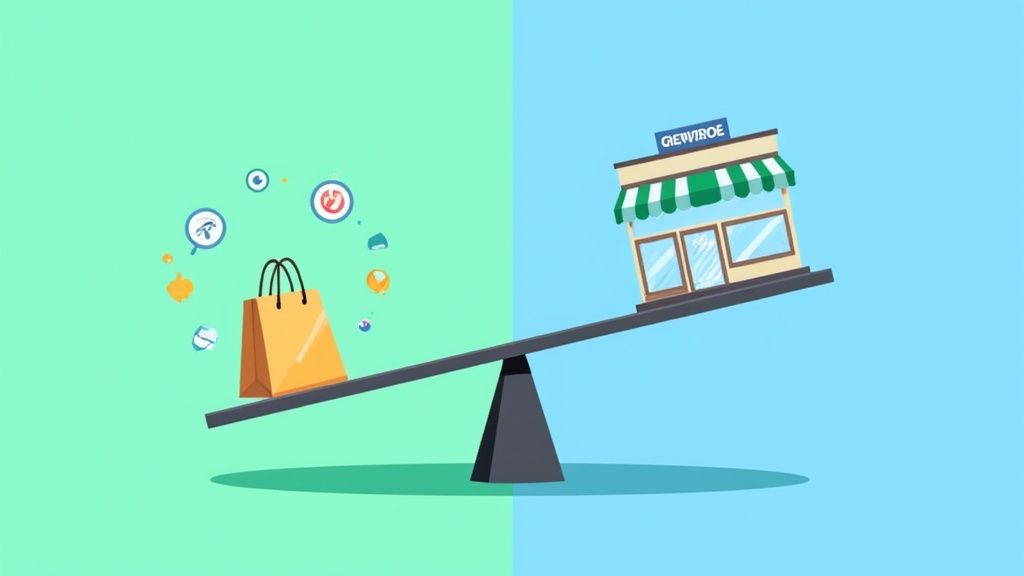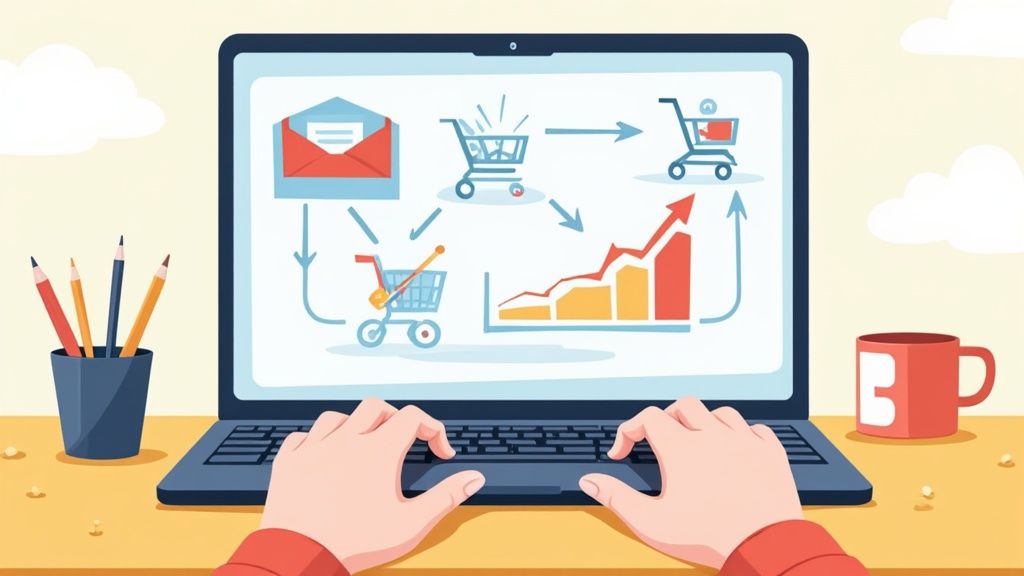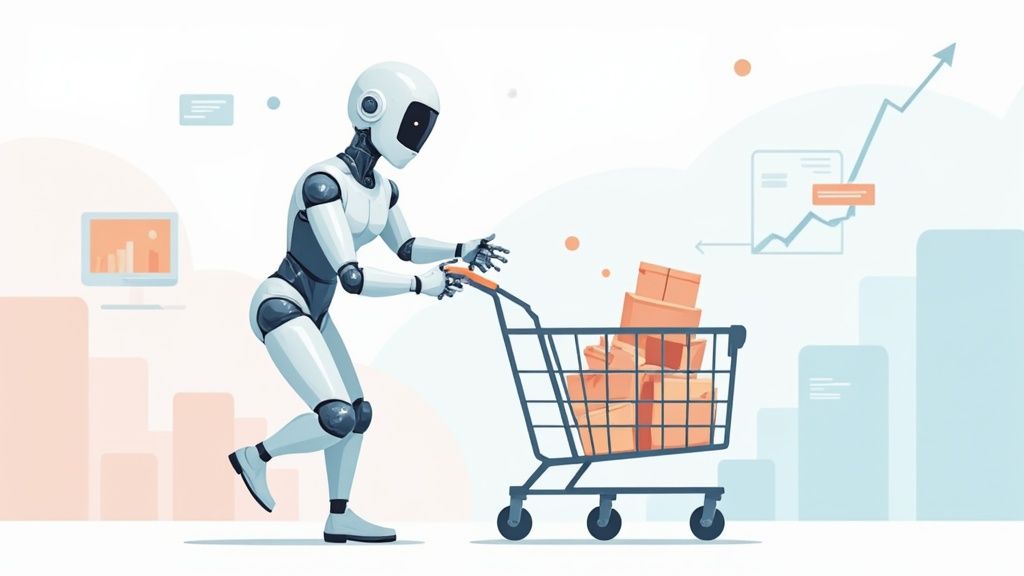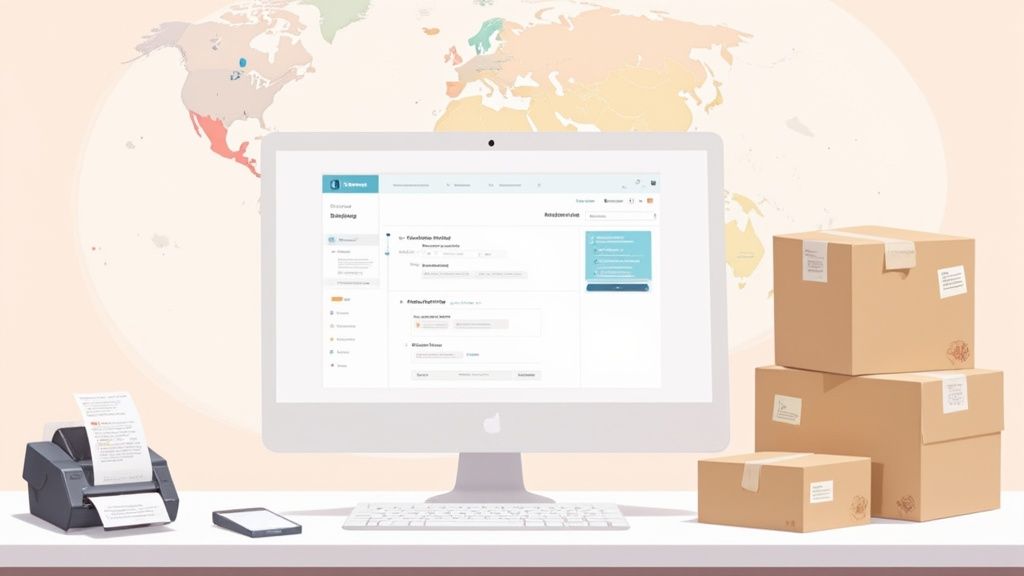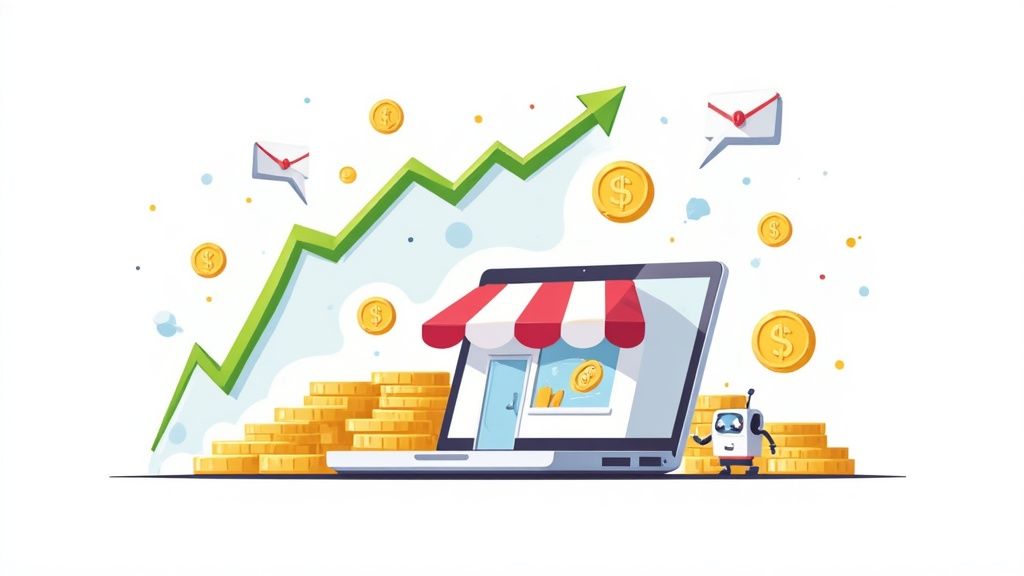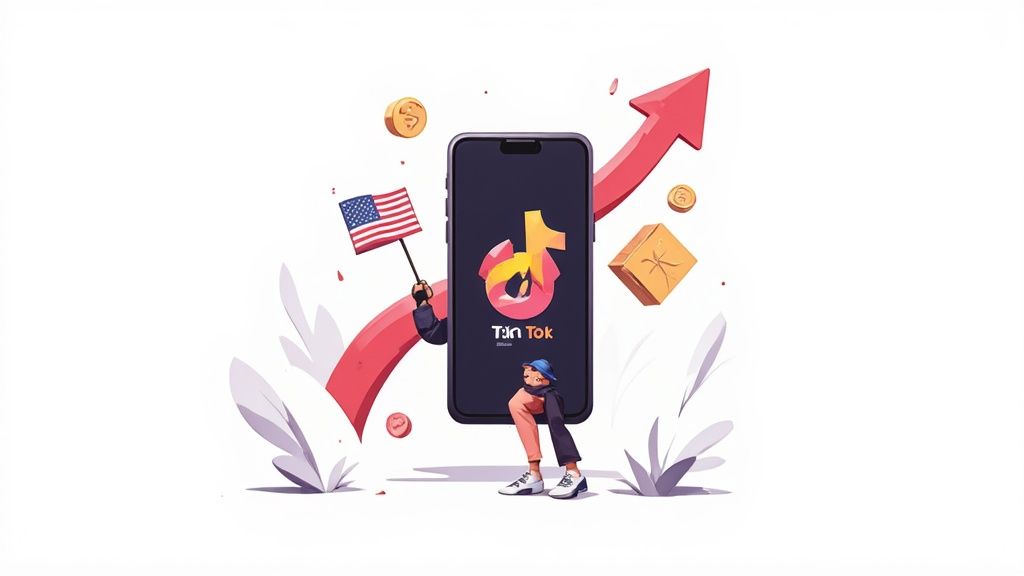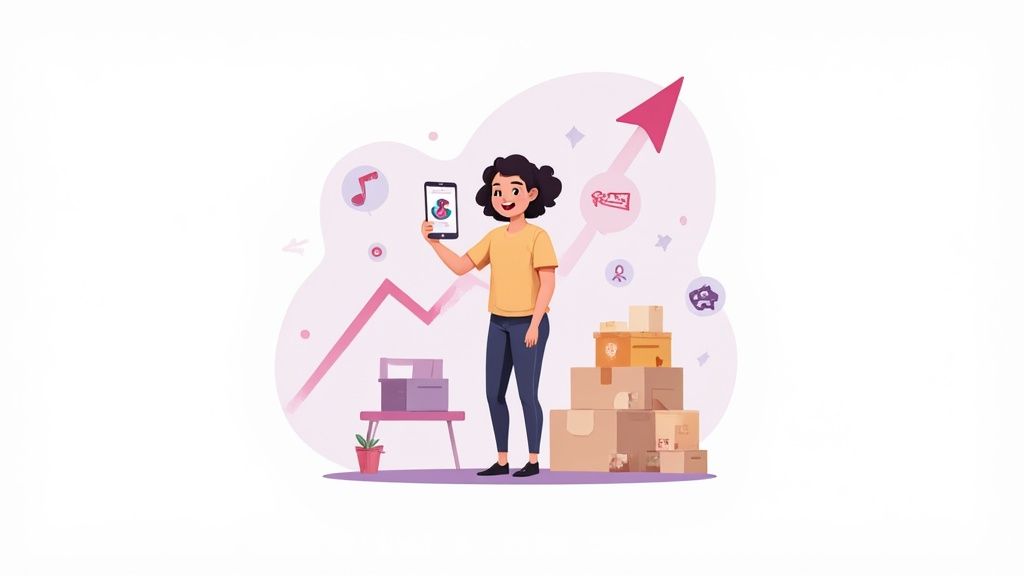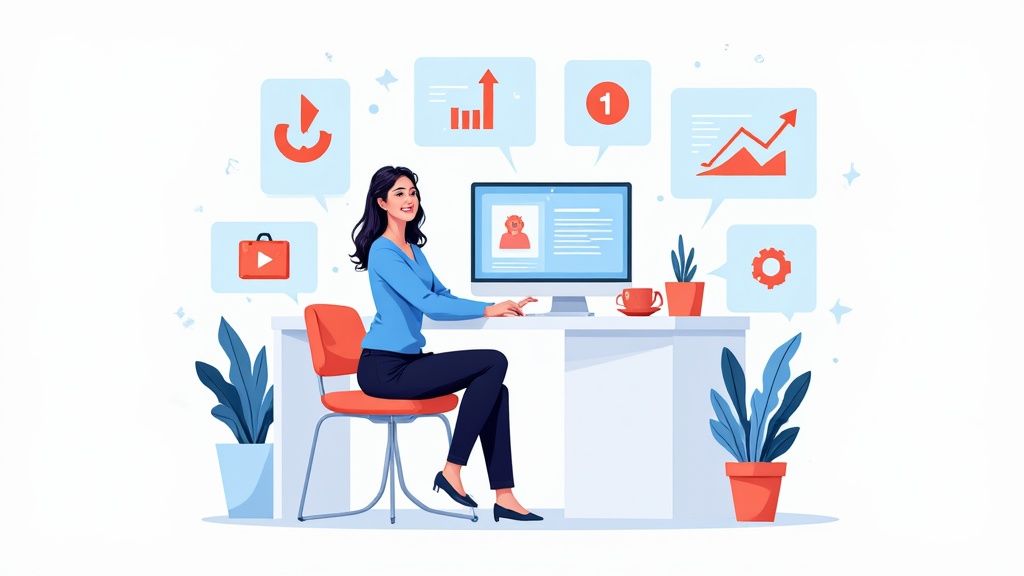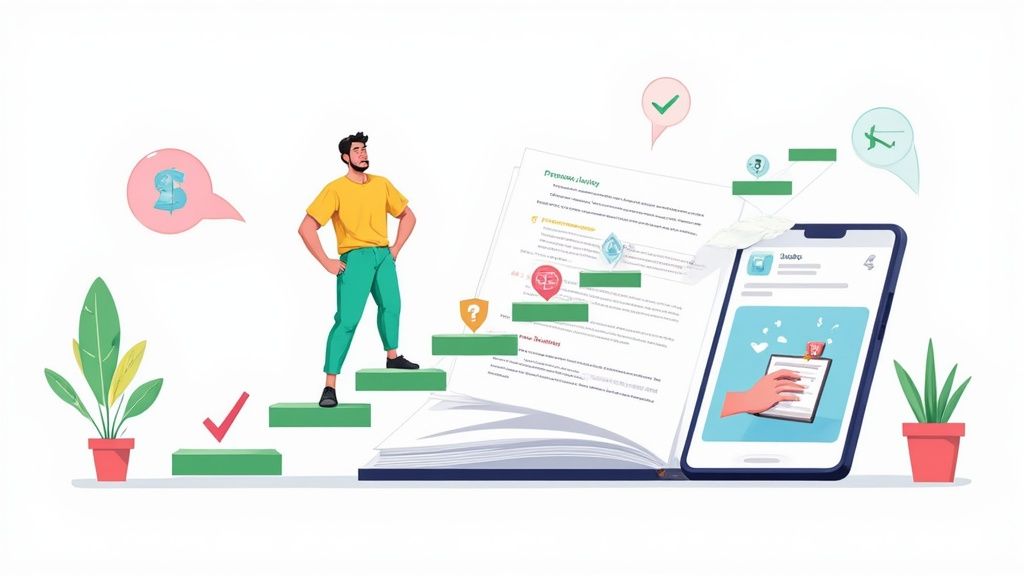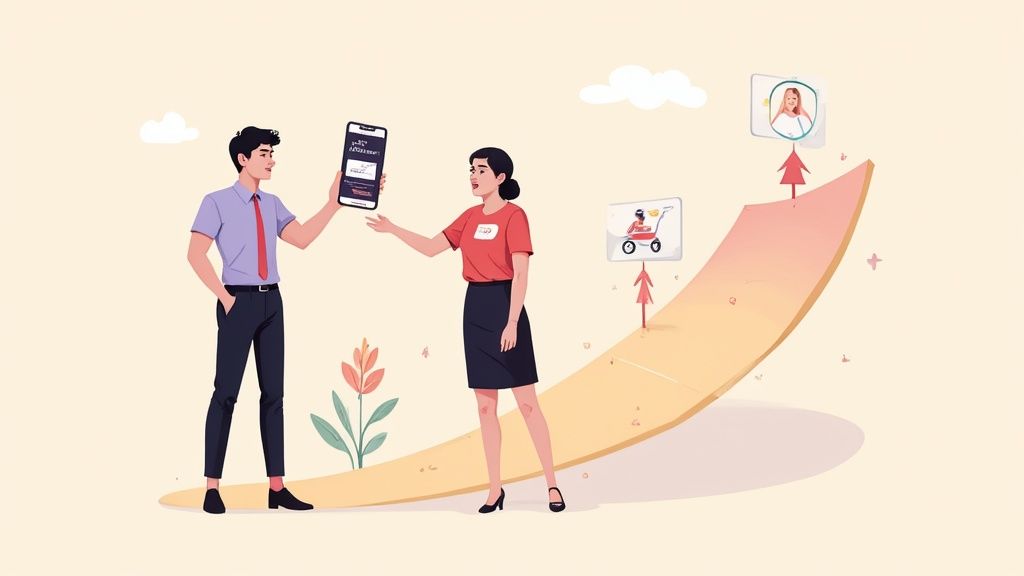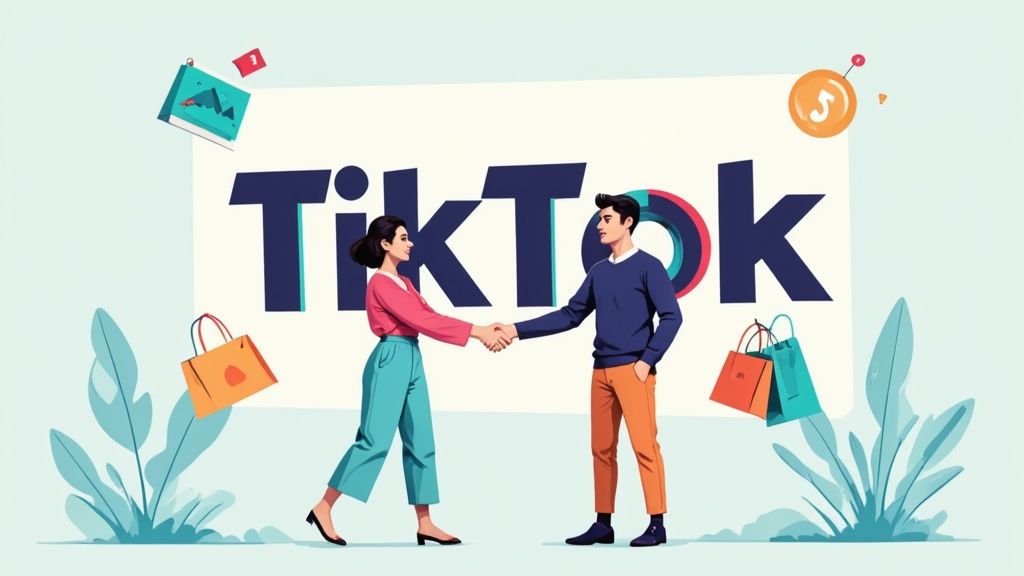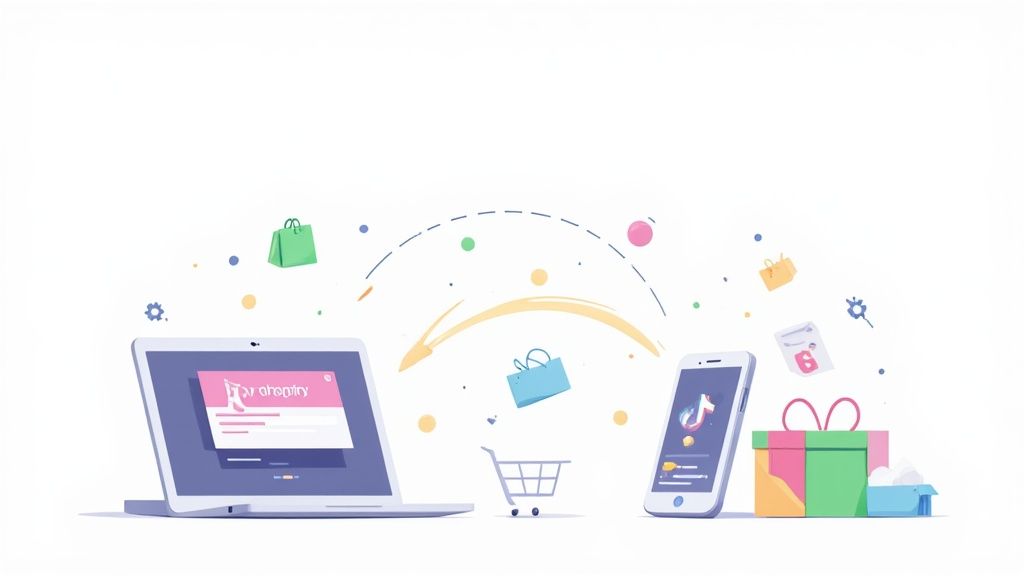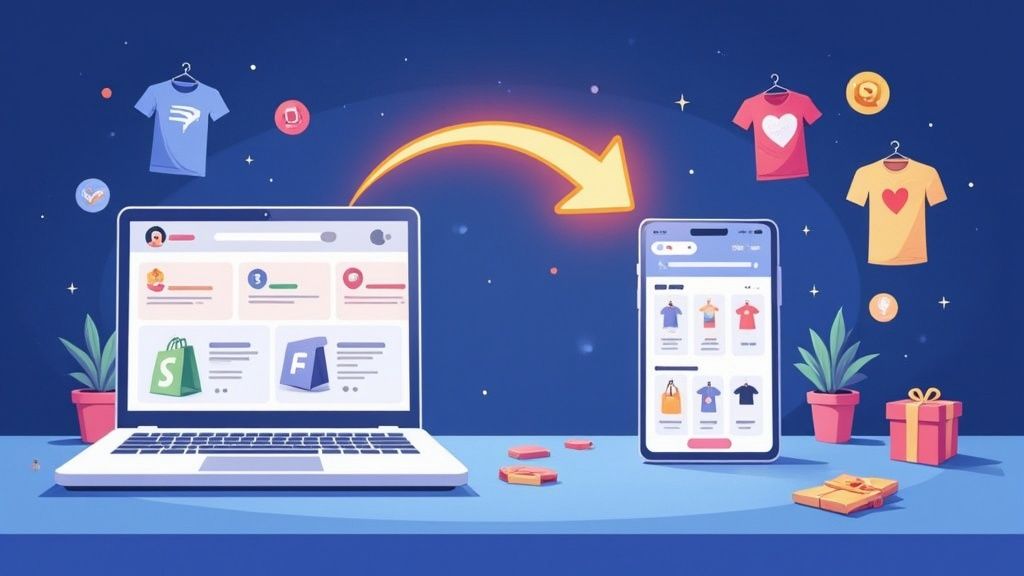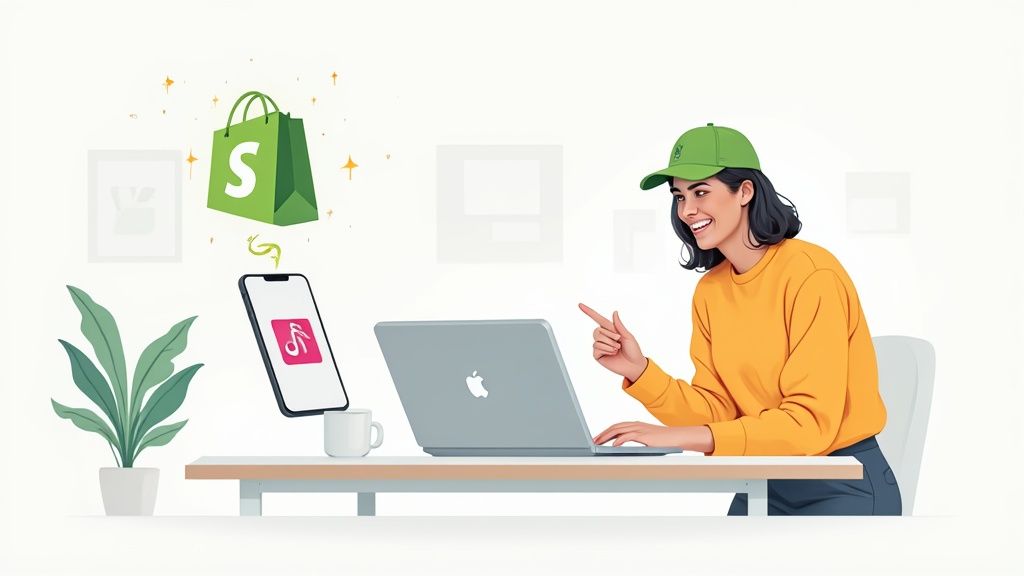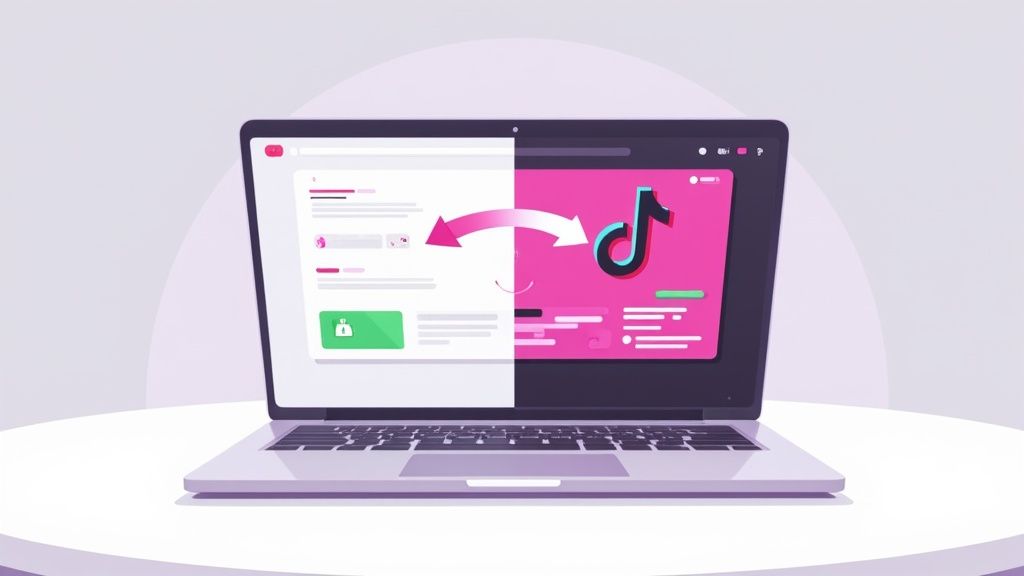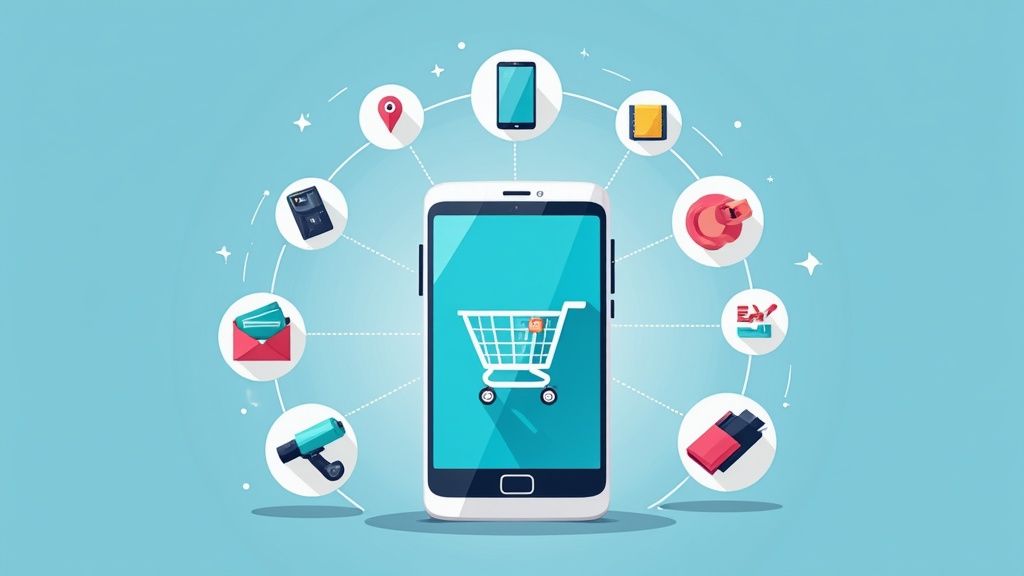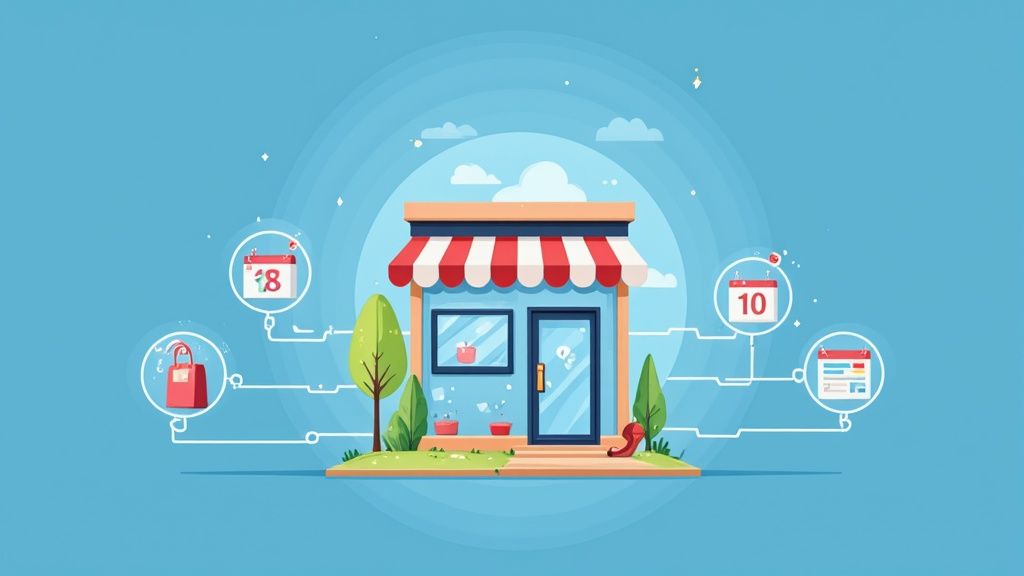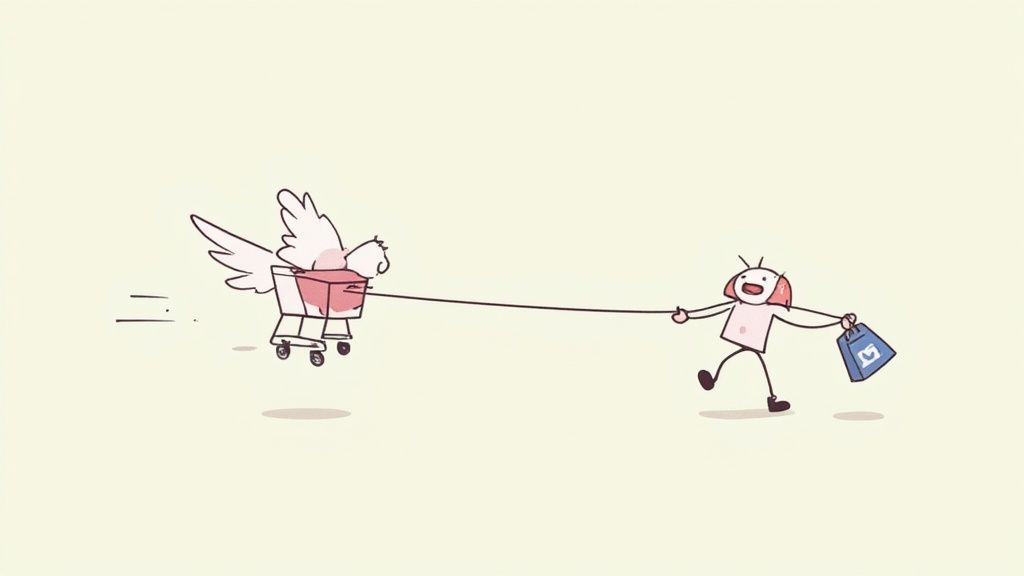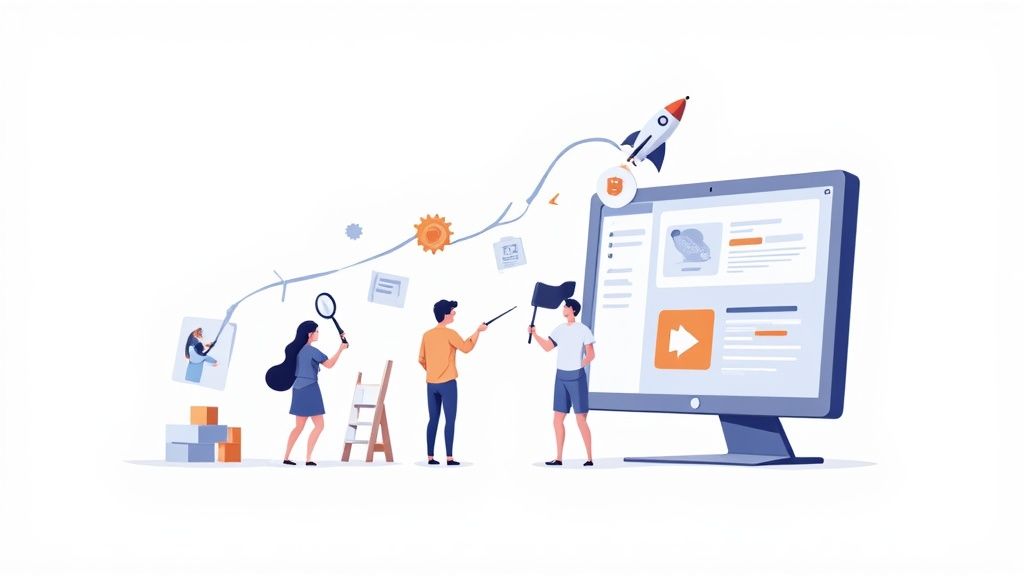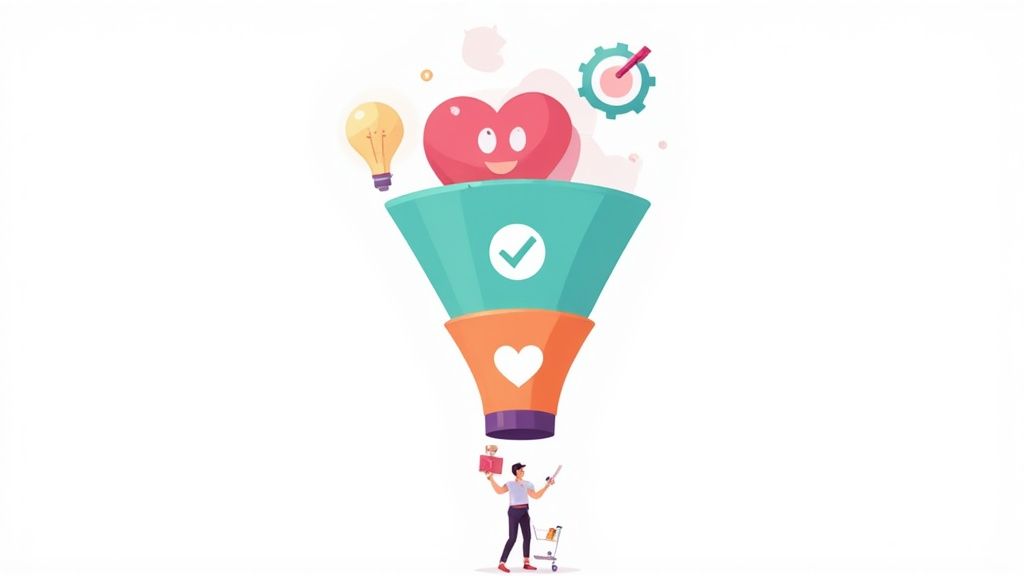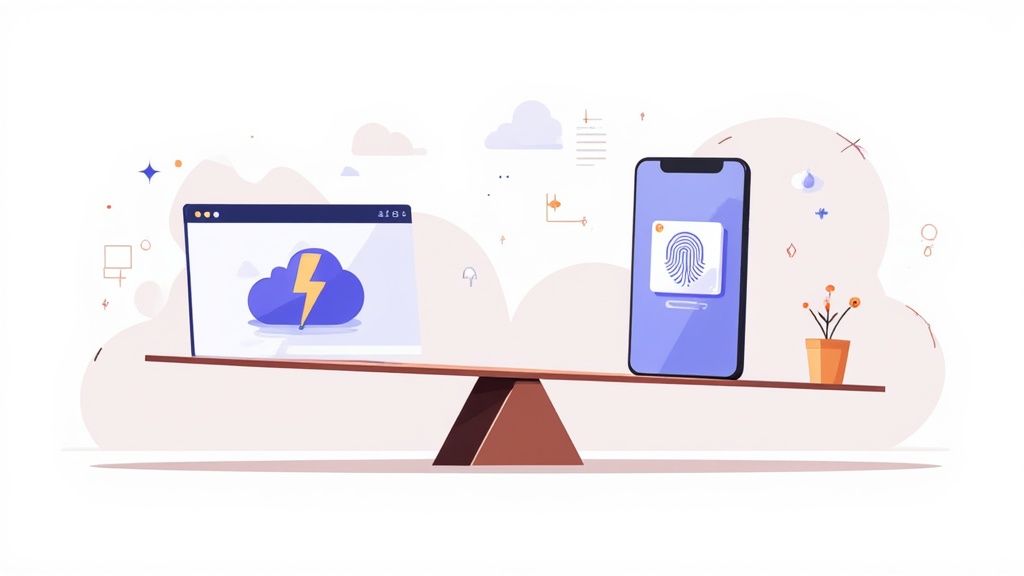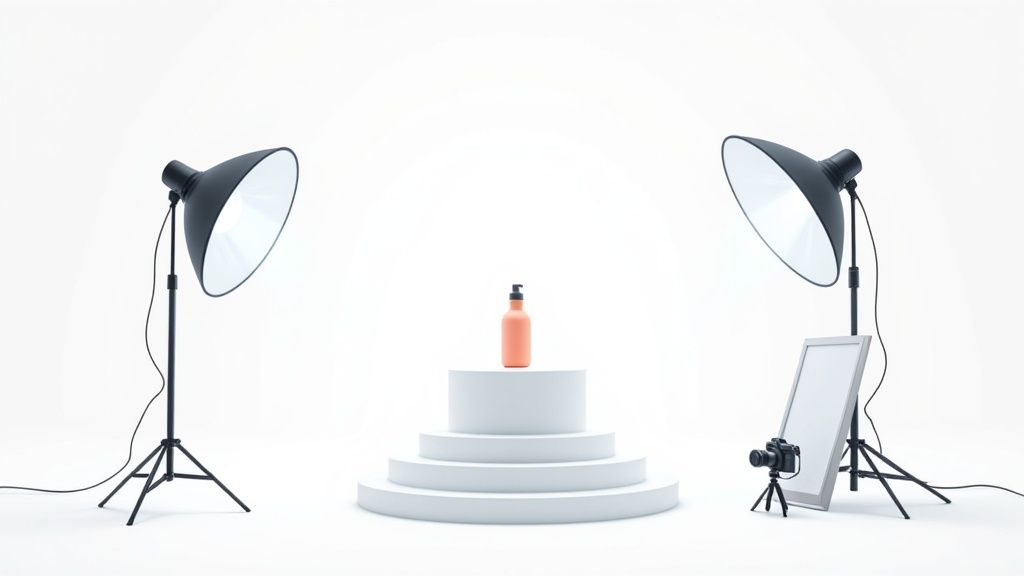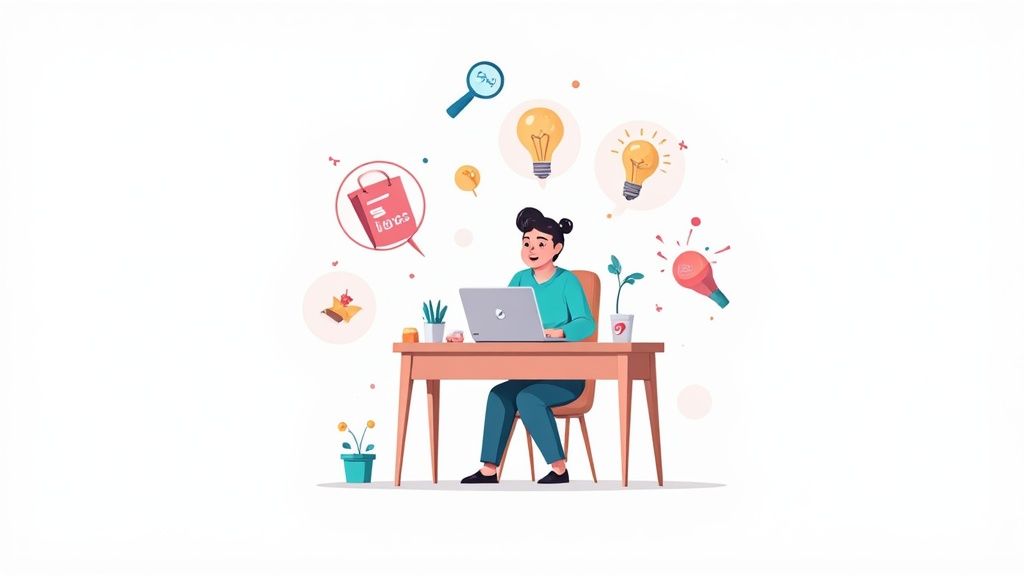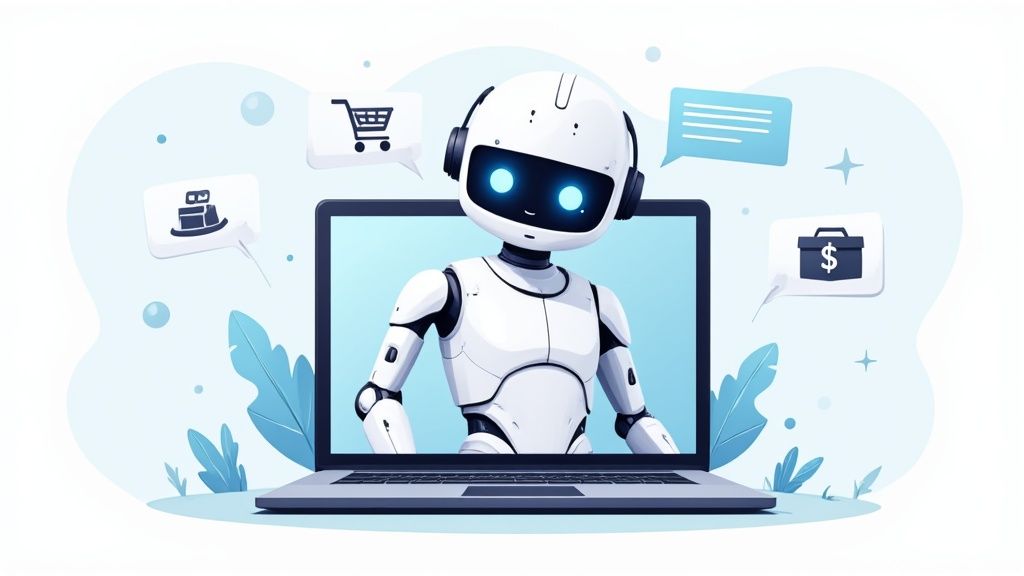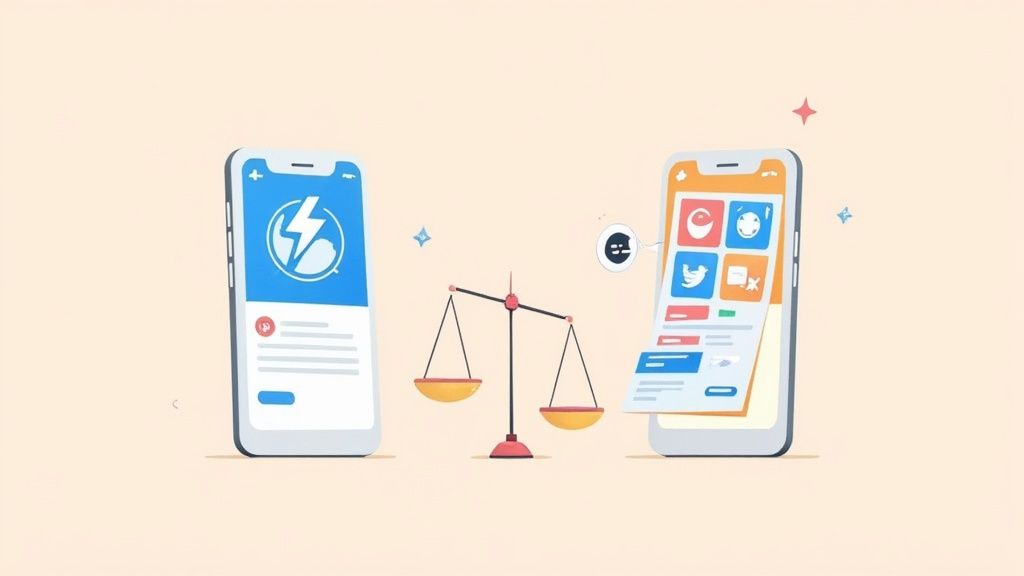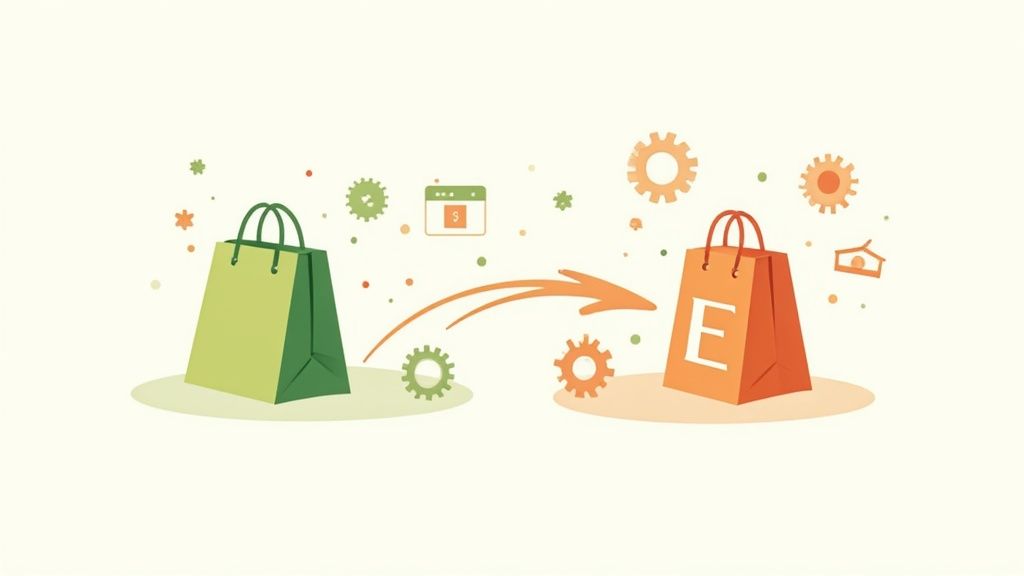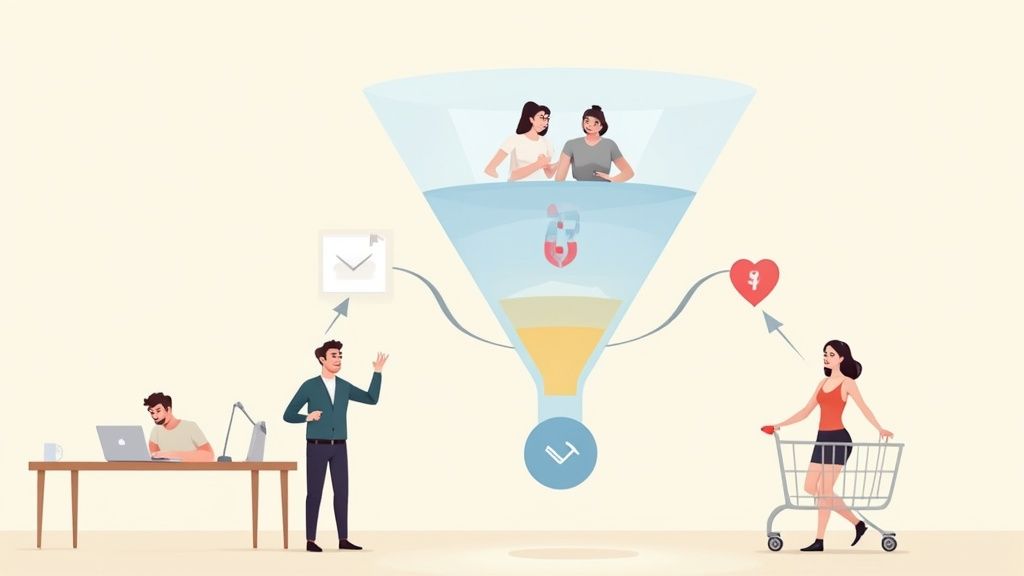
Building a sales funnel that actually works comes down to one core idea: guiding a potential customer through four key stages. You’ve probably heard of it before—it’s the classic AIDA model: Awareness, Interest, Desire, and Action.
The whole point is to deliver the right kind of value at the right time. When you do that, you turn casual window shoppers into loyal customers, all with a journey that feels helpful, not like a hard sell.
Why Most Sales Funnels Fail (And How Yours Will Succeed)
So many businesses get tangled up in building these incredibly complicated systems that just leak customers at every single stage. They obsess over the latest fancy tools before they even grasp the simple psychology behind why people buy.
Here’s the thing: a sales funnel isn't just a technical setup. It's a strategic map of your customer's mind.
The goal is to get beyond the textbook definitions and really dig into the "why" behind each step. For example, the moment a potential customer becomes aware of your brand, they aren't looking for a sales pitch. They have a problem and they're just starting to look for answers. If you shove a product in their face too early, you've lost them. It's that simple.
Mapping the Customer Journey
Your main job is to line up your marketing efforts with what the customer actually needs at that specific moment.
Think of it like a real conversation. You wouldn't walk up to a stranger and immediately ask them to buy something. You'd build a little rapport, show them you know what you're talking about, and then maybe present an offer.
This is what that process looks like, from their first "hello" to the final purchase.

Each stage marks a shift in how your customer is thinking and feeling. That means your approach has to shift right along with them to keep them moving forward smoothly.
And this isn't just for eCommerce. The same principles apply in the B2B world, though the tactics can look a bit different. If you're in that space, it's worth learning how to build a high-converting B2B sales funnel that focuses on building that same sense of trust and value.
Setting Realistic Expectations
Knowing the numbers helps ground your strategy in reality. The average sales funnel conversion rate across all industries hovers around 2.35%. It sounds low, but don't let that discourage you.
Businesses with well-oiled funnels can hit conversion rates of 5.31% or even higher. Not only that, but they often see a 102% higher average deal size. That shows you just how much potential is on the table when you get this right.
The Four Stages of a High-Converting Sales Funnel
To really nail this, you need to understand what's happening at each phase of the AIDA model. This table breaks down what your customer is thinking, what your primary goal should be, and which channels work best at each point in the journey.
By tailoring your messaging and tactics to match the customer's mindset at each stage, you create a path of least resistance straight to the checkout page.
The biggest mistake you can make is treating the funnel like a one-way street. A truly successful funnel creates a positive feedback loop, turning one-time buyers into loyal advocates who bring new customers right back into the top.
When you focus on your customer's needs and build a logical, value-packed path, you sidestep all the common traps that cause other funnels to fall flat. This strategic foundation is the secret to building a system that not only converts but also fosters lasting relationships.
Attracting Qualified Leads at the Top of Your Funnel
The success of your entire sales funnel really boils down to this first step. It's not about casting the widest net possible; it's about attracting the right kind of traffic. Think of it as the grand opening for your funnel—you want a line of eager, qualified customers, not a random crowd of passersby.
Your goal here is to become a valuable resource long before you ever try to be a vendor. This means creating content that solves a problem your ideal customer is actively trying to figure out. It’s all about building awareness by being genuinely helpful.
Define Your Ideal Customer First
Before you write a single blog post or design an ad, you have to know exactly who you're talking to. Without that clarity, your marketing messages will just be generic noise. You need to get inside your customer's head to really grasp their pain points, their goals, and what they’re typing into Google at 2 AM.
This is where creating detailed buyer personas comes in. If you're selling sustainable skincare, your ideal customer isn't just "women aged 25-40." It’s "Eco-conscious Emma," a person who actively seeks out cruelty-free products, follows environmental influencers on Instagram, and worries about the chemicals in her daily routine.
Understanding these nuances is the secret sauce. You can learn exactly how to map out these details in our comprehensive guide on how to create buyer personas.
Content Strategies That Attract the Right People
Once you know who you’re targeting, you can finally start creating content that speaks directly to their needs. This is where you move from planning to action, generating the traffic that will feed the rest of your funnel.
Here are a few proven strategies that work wonders at the top of the funnel:
Targeted SEO and Blog Content: Forget broad keywords like "skincare." Instead, focus on long-tail keywords that signal real intent. A blog post titled "A Beginner's Guide to Building a Sustainable Skincare Routine" is going to attract a much more qualified audience than something generic. This approach pulls in visitors who are already searching for the exact solutions you offer.
Engaging Social Media Campaigns: Use platforms like Instagram or TikTok to show your product solving a relatable problem. A quick video showing how your eco-friendly laundry detergent removes a tough stain without any harsh chemicals is way more compelling than a static product shot. It's storytelling in action.
Value-Driven Lead Magnets: The bridge between an anonymous website visitor and a potential customer is your lead magnet. This is a valuable piece of content you offer up in exchange for an email address. The key is to offer something genuinely useful that provides a quick, satisfying win for them.
A great lead magnet doesn't just collect an email; it provides immediate value and positions your brand as a trusted expert. It's the first handshake in what you hope will be a long-term relationship.
For an eCommerce brand, effective lead magnets are all about solving a specific problem. Some ideas could be:
- A downloadable checklist like "10 Harmful Skincare Ingredients You Need to Avoid."
- A short, insightful ebook such as "The Ultimate Guide to Building a Zero-Waste Kitchen."
- An interactive quiz that helps users find their perfect product, like "What's Your Skin's True Type?"
By focusing on providing real value right from the start, you attract an audience that's not only interested in what you have to say but is also far more likely to trust you when it's time to make a purchase. This strategic approach ensures your funnel is filled with high-quality leads from the get-go.
Building Trust and Desire in the Middle Funnel
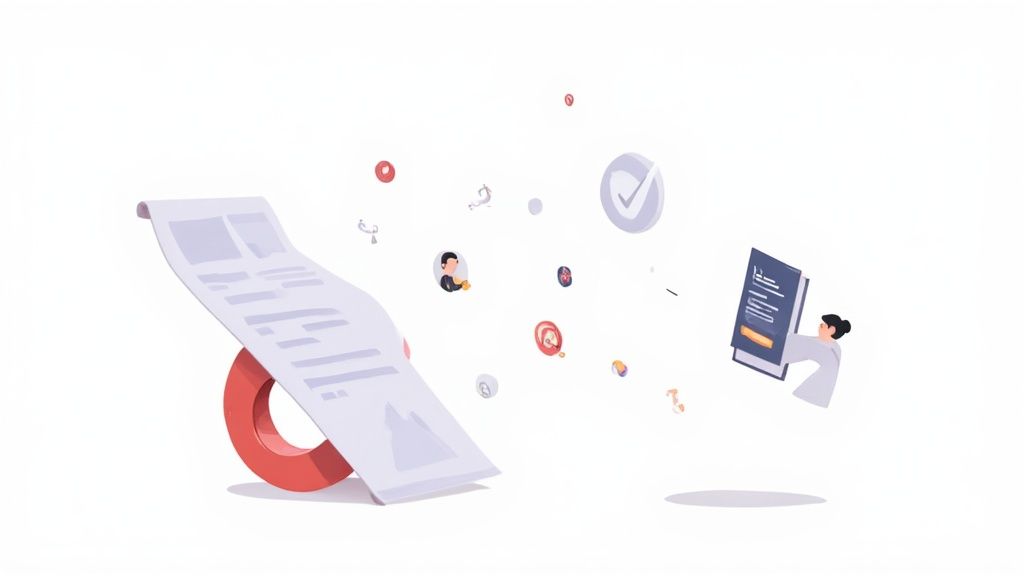
Alright, you did it. You captured their attention, they handed over their email address, and now they're officially in your world. Big win, but the real work starts now.
We're moving into what’s known as the middle of the funnel (MOFU). This is the crucial nurturing phase where you shift from just grabbing attention to actually building a relationship. The goal here is simple: turn their mild curiosity into a genuine desire for what you're selling.
Forget the hard sell. The middle of the funnel is all about education, connection, and earning their trust. Nail this part, and the final sale feels less like a conversion and more like the natural next step.
Crafting a Compelling Email Nurture Sequence
Email is your absolute best friend in the middle funnel. It’s your direct line to a lead, allowing you to deliver value and build rapport one message at a time. A smart email sequence can guide someone from "interested" to "I need this" without ever feeling pushy.
I like to think of it as a three-part conversation. Each email has a specific job to do.
A sequence that consistently works well for us looks something like this:
The Welcome & Value Drop: This one has to be instant. It confirms they subscribed and, most importantly, delivers the freebie they signed up for. Keep it friendly, quick, and focused on delivering that initial promise.
The Relatable Story: A couple of days later, hit them with a story they can see themselves in. Maybe it's a customer's journey from struggle to success. The point is empathy—you're showing them you get their problem on a personal level.
The Gentle Introduction: Now that you've built a bit of trust, you can bring your product into the picture as the solution. Don't list features. Talk about the transformation. How does your product make their life better?
The best email sequences don’t just sell a product; they sell a better version of the customer’s future. By focusing on their transformation, you create an emotional connection that features and specs alone can never achieve.
This whole process is built on providing value before asking for the sale. You educate them, validate their struggles, and then position your product as the clear, logical solution.
Using Smart Retargeting to Stay Top-of-Mind
Let's be real—not everyone is going to buy after three emails. That's perfectly normal, and it's where smart retargeting comes into play. Using platforms like Facebook, Instagram, and Google, you can show targeted ads only to people who are already on your email list or have checked out specific pages on your site.
This is how you prevent interested leads from slipping through the cracks. The trick is to make these ads feel like a helpful nudge, not an annoying interruption.
Here are a few retargeting angles that kill it in the middle funnel:
- Show Off Your Social Proof: Run ads that feature your best customer testimonials or case studies. Nothing is more persuasive than seeing real people raving about your product.
- Handle Objections Head-On: Create ads that tackle common hang-ups. Got a lot of questions about shipping? Run an ad highlighting your free shipping policy. Worried about returns? Showcase your satisfaction guarantee.
- Share More Value: Retarget leads with ads that link to a genuinely helpful blog post or a video tutorial. This keeps them engaged and reinforces your brand as the go-to expert.
When you pair a great email sequence with strategic retargeting, you create a powerful nurturing machine. You stay on their radar, build serious credibility, and gently guide them toward the finish line: making a purchase.
Designing a Frictionless Bottom-Funnel Experience
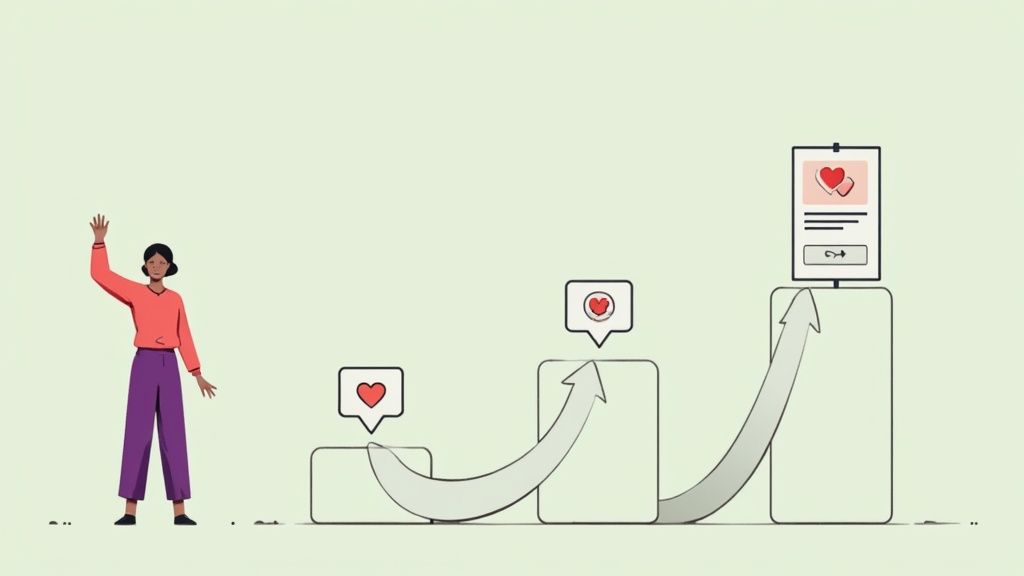
This is it—the moment of truth. After all your hard work attracting and nurturing a potential customer, they’ve landed on your product page, ready to buy. The bottom of the funnel (BOFU) is where you turn that strong interest into a real sale, and every single detail matters.
Your job here is to make the decision to buy an enthusiastic "yes!" This means knocking down every possible barrier, answering last-minute questions, and building unwavering trust right at the finish line. A single confusing step can undo everything you’ve achieved so far.
Crafting a Product Page That Sells
Think of your product page as your final, most important salesperson. It needs to do more than just display pretty pictures; it has to crush objections, build excitement, and make your offer feel like a no-brainer.
Go beyond just listing features. You need to frame everything in terms of benefits and the transformation your customer will experience. How does this product make their life easier, better, or more fun?
Here are the non-negotiables that make a product page convert:
- High-Quality Visuals: Use crystal-clear images from every angle, videos of the product in action, and even 360-degree views if you can. Let people see exactly what they're getting.
- Compelling Copy: Your description should be engaging and answer key questions before they're even asked. Directly address potential concerns about materials, sizing, or how to use it.
- Powerful Social Proof: Make your star ratings, customer reviews, and user-generated content (like photos from Instagram) impossible to miss. Seeing that other people love your product is often the final push someone needs.
To really ramp things up, consider creating a sense of urgency. For instance, adding a countdown timer to your website to boost urgency and sales can be a powerful motivator for limited-time offers.
Slashing Cart Abandonment at Checkout
Getting an item into the cart is a huge win, but the game isn't over. The global average cart abandonment rate is a staggering 70%. That’s a ton of lost revenue, usually because of a clunky or confusing checkout process.
Your checkout has to be fast, simple, and totally transparent. Every extra field a customer has to fill out or every unexpected fee is just another reason for them to walk away.
A frictionless checkout experience is one of the highest-leverage improvements you can make to your entire sales funnel. It directly translates hesitation into completed sales.
Here’s how to lock in those conversions at checkout:
- Offer Express Payment Options: Seriously, this is a must. Integrate one-click payment methods like Shop Pay, Apple Pay, and Google Pay. Returning customers can check out in seconds, which massively reduces friction.
- Simplify Form Fields: Only ask for what you absolutely need. Do you really need their phone number? Can you auto-fill their address? The fewer keystrokes, the better.
- Be Transparent About Costs: Surprise shipping fees are the #1 killer of conversions. Display all costs—including shipping and taxes—clearly and right up front. Never, ever hide them until the final step.
By obsessing over the details on your product pages and streamlining your checkout, you build the final, crucial bridge in your sales funnel. This focus at the bottom of the funnel ensures a customer's journey ends not with frustration, but with a satisfying, seamless purchase.
Optimizing Your Funnel with Real-World Data
Launching your sales funnel isn't the finish line. It's the starting pistol. The most profitable funnels are living, breathing systems that you constantly tweak and improve based on how real people actually interact with them. This is where you stop guessing and start making smart, data-driven decisions that crank up your conversion rates.
Honestly, becoming a data detective is the single most important skill for turning a decent funnel into a high-converting machine. It all starts with tracking the right numbers—not vanity metrics, but the data that tells you the true story of your customer's journey.
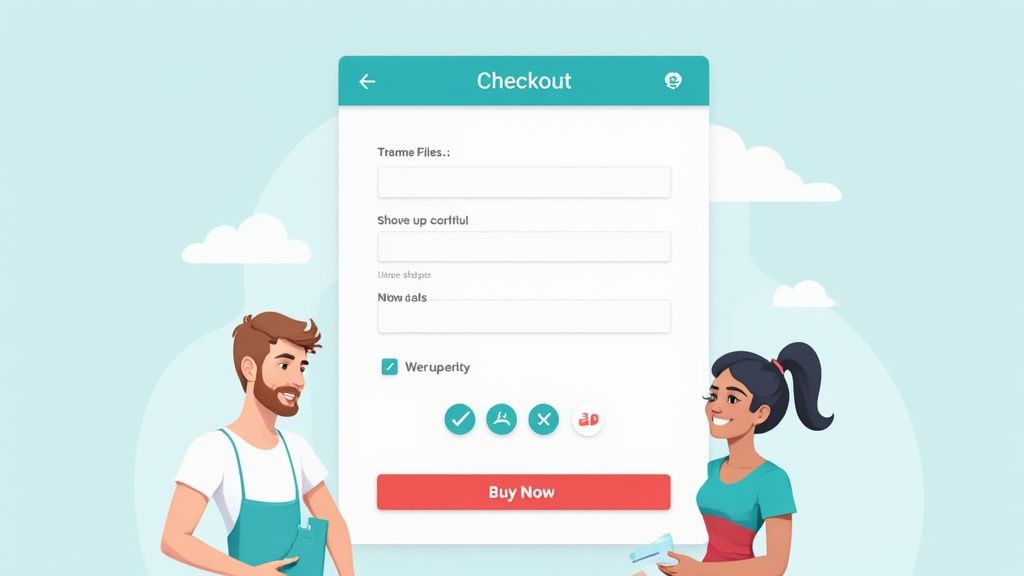
Identifying Your Key Funnel Metrics
To figure out where your funnel is leaking cash, you first need to know what to measure. The trick is to focus on the metrics that show you exactly where users are dropping off, so you can plug the holes.
Here are the key performance indicators (KPIs) you should have on your dashboard:
- Stage-by-Stage Conversion Rate: What percentage of people move from your landing page to your product page? From the product page to checkout? This tells you exactly where your biggest friction points are.
- Customer Acquisition Cost (CAC): How much are you actually spending to get one new customer through the door? If this number is higher than what people are spending, you have a problem.
- Customer Lifetime Value (LTV): How much does the average customer spend with you over their entire relationship with your brand? A high LTV means your funnel is attracting valuable, repeat buyers—the best kind.
The goal isn't just to make a single sale; it's to create a profitable, repeatable system. When your LTV is at least 3x higher than your CAC, you've built a sustainable engine for growth. That’s the magic ratio.
Pinpointing and Fixing Leaks
Once you've got your core numbers, it’s time to dig deeper. Tools like Google Analytics are great for spotting which pages have high exit rates, while heatmaps can show you what users are clicking on—or, more importantly, what they're ignoring completely.
For example, I once worked with a client whose heatmap showed that almost no one was clicking their main call-to-action button. Why? It was buried below the fold. A simple tweak to move it higher up the page resulted in an immediate lift in conversions. That’s a clear, actionable insight.
This is where a detailed conversion funnel analysis becomes your secret weapon, helping you interpret the data correctly and prioritize what to fix first. From there, you can start running simple A/B tests. Test one thing at a time—change a headline, tweak your offer, or alter a button color—to see what truly resonates with your audience. This methodical approach is how you systematically, and predictably, improve your results.
Answering Your Top Sales Funnel Questions
Even with the best blueprint in hand, building a sales funnel always brings up questions. It's a big concept with a lot of moving parts, and it's totally normal to get hung up on the details. Let's walk through some of the most common questions I hear from eCommerce brands to help clear things up.
One of the biggest points of confusion is the difference between a sales funnel and a marketing funnel. I get asked this all the time. The easiest way to think about it is that the marketing funnel comes first. Its main job is to cast a wide net—building brand awareness and getting people familiar with who you are and the problems you solve.
The sales funnel takes over from there. It grabs those interested prospects from the marketing funnel and pulls them into a more structured journey with one clear goal: making a purchase. They definitely overlap, but marketing is about attracting the crowd, and sales is about converting the individual.
How Long Should My Funnel Be?
There's no golden rule here. The ideal length of your sales funnel really depends on what you're selling and who you're selling it to.
For a simple, low-cost B2C product—think a trendy phone case or a new coffee blend—the funnel can be incredibly short. Sometimes you can take a customer from discovery to purchase in a single day.
But if you're selling a complex B2B service or a high-ticket item like custom furniture, that sales cycle is naturally going to be longer. The decision-making process is more involved, requiring more research, more comparison, and often, more people signing off on the purchase.
Your funnel should be as long as it needs to be to build trust and answer every single one of your customer's questions. Rushing it is the fastest way to lose a sale. The focus should always be on providing value at each stage, not on speed.
Do I Need Different Funnels for Different Products?
Yes, 100%. A one-size-fits-all funnel is a recipe for mediocre results. Think about it—each of your products probably solves a slightly different problem or appeals to a unique type of customer. Your funnel needs to reflect that.
You should absolutely tailor your funnels for each major product category or key customer persona you have. This is how you create super-relevant messaging and offers that feel like they were made just for them.
Here are a few scenarios:
- For a new product launch: This funnel would be heavy on education and building hype. You might use webinars, behind-the-scenes content, and early-bird offers to build momentum.
- For a best-selling item: This funnel can be more direct. You already have proof it's a winner, so you can lean on customer testimonials, user-generated content, and social proof to push for a quick decision.
- For a subscription service: Here, the entire focus shifts to demonstrating long-term value. The funnel would be built around making the free trial or sign-up process as frictionless as possible and showing the customer what life is like with your product.
Creating these distinct funnels is what ensures your messaging stays sharp and effective, which is the key to maximizing conversions across your entire product line.
At ECORN, we live and breathe this stuff. We specialize in designing and optimizing high-converting sales funnels specifically for Shopify brands. If you're ready to turn more of your browsers into loyal buyers, explore our eCommerce solutions today.






